



















WE handle every day those small metal coins that jingle in our pockets, pile up in piggy banks or get handed over without a second glance. Yet, for a certain group of people, these ordinary bits of currency carry far more than just face value.
Meet the numismatists, or collectors and enthusiasts who find fascination in the details of old coins, paper money, medals and other relics that connect us to the past. It may seem like a niche pursuit. After all, not everyone gets excited over the difference between two near-identical peso coins. But if you have ever wondered how deep that rabbit hole goes, Minted MNL, a hub for collectors, learners, and history lovers alike, might be a good place to start.
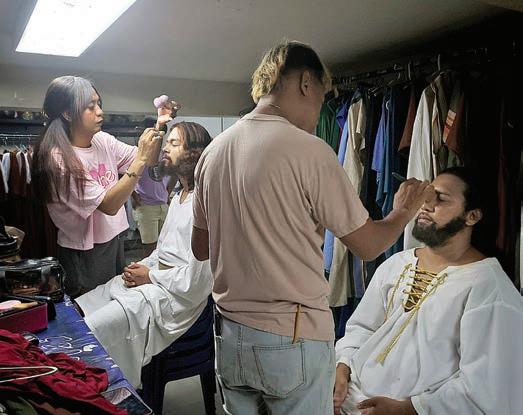


“Every


At the helm is Sigrid Carandang, Minted MNL chairperson, who sees it as a gateway to discovery and a way to preserve pieces of history, one coin at a time.
More than an event, Minted MNL is a movement—a celebration of the artifacts that connect us to the past and shape the way we preserve history for future generations,” she told the BusinessMirror
Every piece has a journey, every coin tells a story, and at Minted MNL, we create opportunities to share these stories with the world,” she added.
Starting point
BUT where does one even begin?
Carandang said the organization’s mission goes beyond just the buying and selling of coins. Whether you’re just starting or you’re a seasoned numismatist,
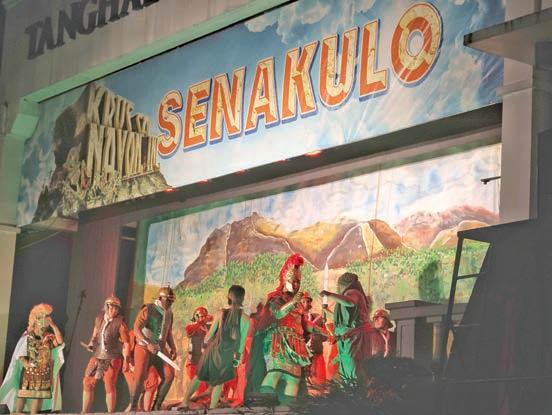
Minted MNL is the perfect place to immerse yourself in the hobby, meet kindred spirits, and become part of something truly extraordinary,” she assured.
Even Carandang herself didn’t expect to end up in this world. Her first memory of coin collecting was as a child, eagerly checking her grandfather’s pockets for any shiny coin he brought home as a pasalubong What started as a childhood fascination with these small treasures quickly evolved into a lifelong passion for history, craftsmanship, and the incredible stories each coin carries,” she said.
Coining a legacy WHAT started as a local spark in 2016 has minted itself into the Philippines’ leading stage for coin collectors and enthusiasts.
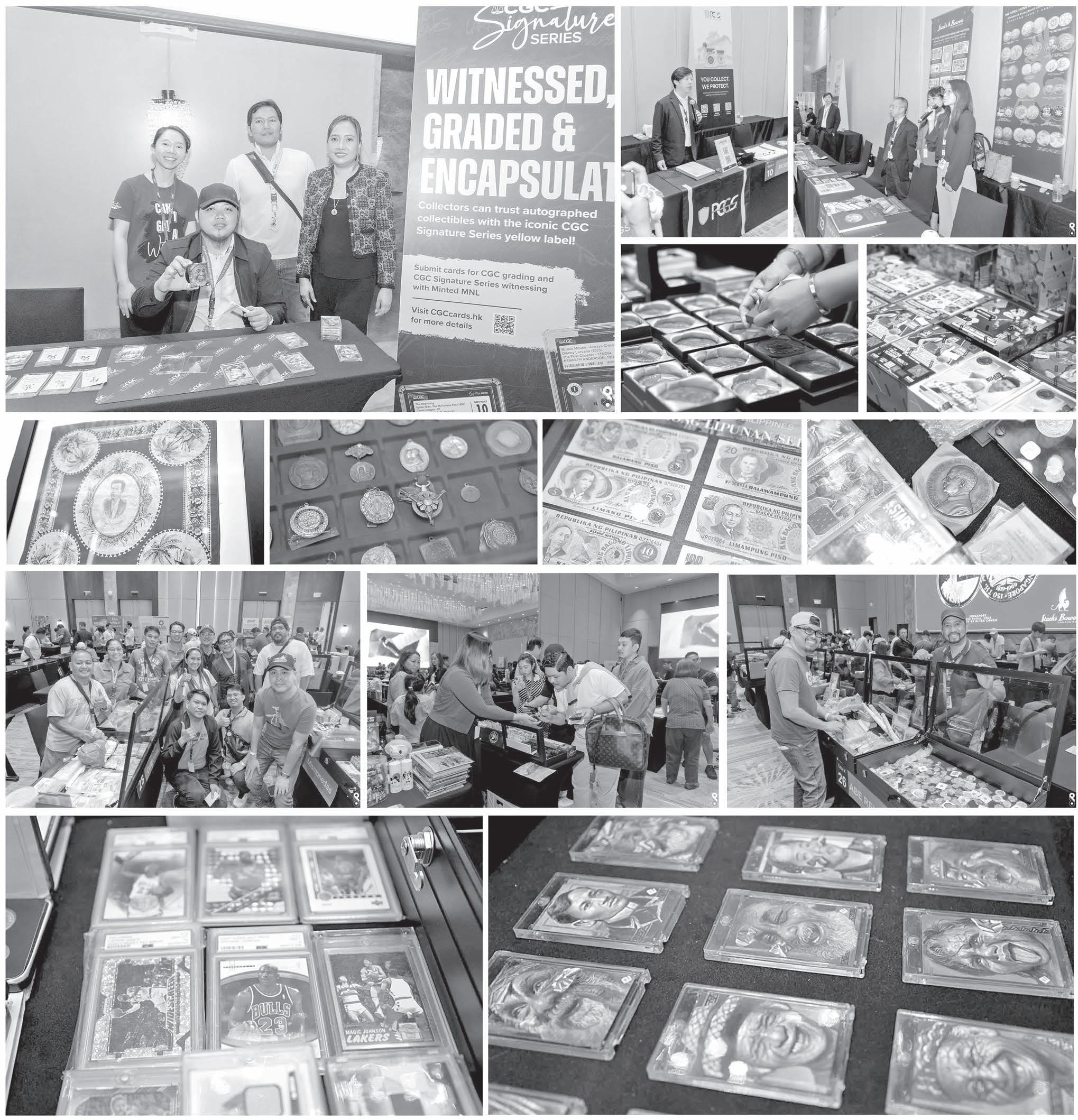
They
ed its Summer Show—two days of rare finds, exhibits, and shared excitement that drew both seasoned hobbyists and curious newcomers. Up next is the Minted MNL Year-End Show, happening on November 22 and 23. Dubbed The Gathering of Lights, this event promises a more festive tone in line with the Christmas season. According to Carandang, the year-end show will highlight premium collectibles, rare coins, and high-value items, while still being welcoming to newcomers. Attendees can expect exclusive releases, expert-led talks, and the chance to meet some of the most respected voices in the collecting community. For the Minted MNL founder,
creating these spaces was a response to a long-standing gap, particularly in infrastructure and accessibility. “The local numismatic community was small, and opportunities to connect with experts, verify items, and expand collections were limited,” she said.
W hile the Philippine numismatic scene is gaining traction, with Minted MNL’s auctions now drawing thousands, for instance, it’s still catching up to the more established global markets.
BSP’s role
THE Bangko Sentral ng Pilipinas (BSP) plays a key role in local coin collecting by issuing commemorative coins and notes that mark sig-
nificant historical events. These are available through the BSP Online Store and come with certificates of authenticity upon release.
However, for collectors seeking global recognition, authentication often goes beyond local certifications.
Carandang noted that the internationally recognized grading bodies, like PCGS and CCG, are the gold standard for authentication, where NGC (Numismatic Guaranty Corporation) and PMG (Paper Money Guaranty) belong.
PCGS and CCG place the items in a slab, which protects the items from wear, tear and is airtight and waterproof.
“Our company joint venture is
the first and only official submission center in the Philippines for coins, paper money, medals, tokens and cards,” Carandang said.
‘Let the coin resonate’ IF you’re new to the world of numismatics, Carandang’s advice is simple: follow your curiosity.
“Start with what fascinates you,” she said. “Whether it’s ancient coins, modern bullion, or commemorative pieces, collect what speaks to you.”
She also emphasized the importance of continuous learning, such as reading books, attending events, and engaging with seasoned collectors for valuable insights.
Moreover, Carandang reminded collectors to always verify authenticity. “Be mindful of counterfeits and work with trusted organizations like PCGS, NGC, and PMG to protect the integrity of your collection,” she said. A bove all, she encouraged collectors to enjoy the process. “The real joy of collecting isn’t just in acquiring items, but in the stories, friendships, and knowledge you gain along the way.” Through collecting, you are not just investing in assets—you are safeguarding the legacy of civilizations, honoring artistry, and keeping history alive,” she added. Edwin P. Sallan contributed to this report.

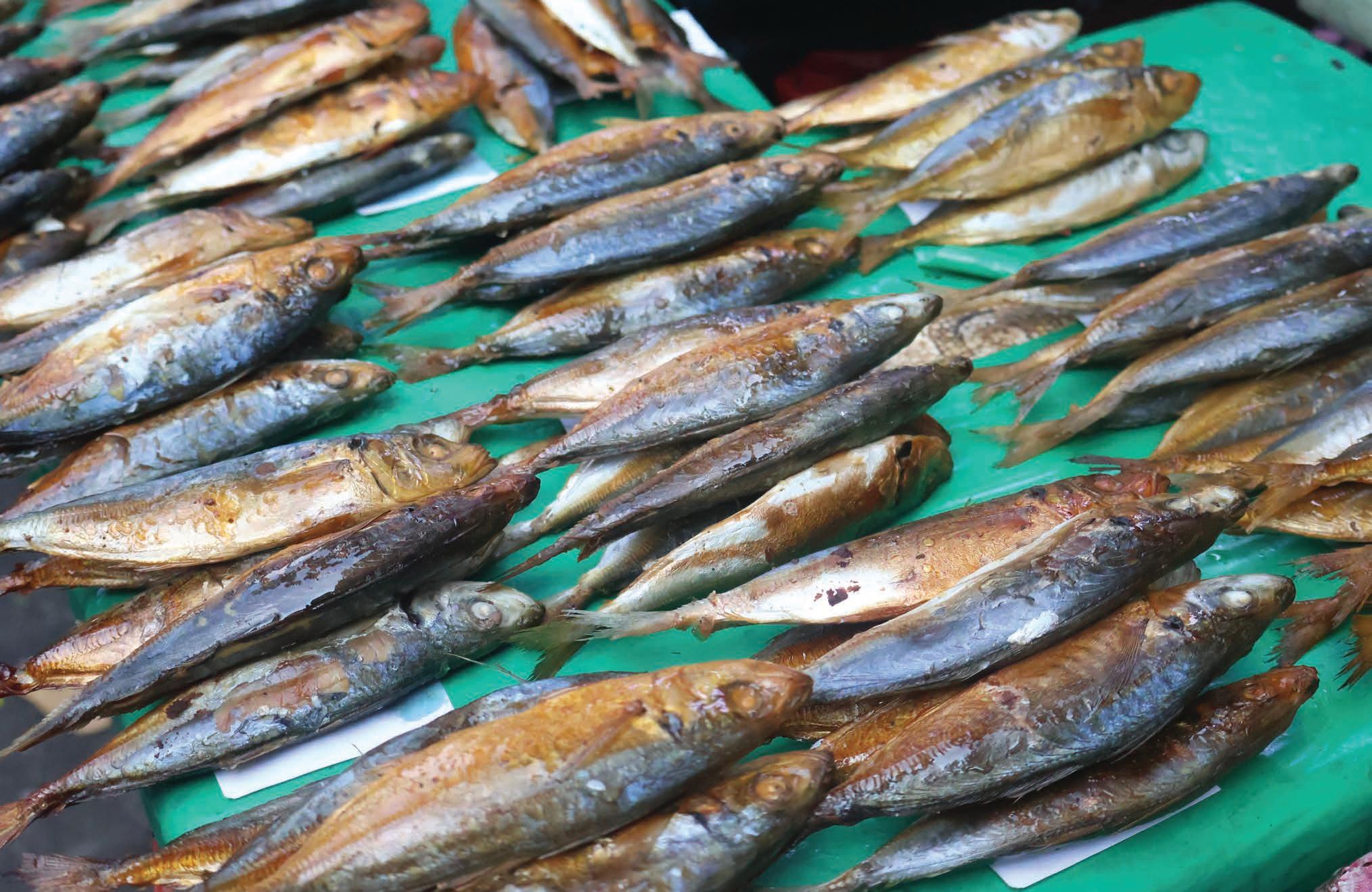
TINAPA has long been considered by producers and vendors as the “golden fish” with its smoked, crispy skin evoking colors of royalty.

But recently, the likes of Renz Dela Cruz, a 24-year-old tinapa vendor, have been seeing the smoked fish take on a different glimmer as its cost continues to rise akin to a gold price rally.
The price of tinapang galunggong (roundscad) in Quiapo markets has doubled on an annual basis to P100 for a pack of five to seven pieces. The reason? Galunggong supply has been tight with imports deemed insufficient to plug the shortfall in local production.
Ramdam po talaga ’yan kasi nawalan tayo ng isda eh. Matagal. Isang buwan. Ngayon lang ulit tayo nagkaro’n [ng tinapang galunggong], nitong buwan lang [That lack is really felt because we didn’t have the fish...for a month. It’s only now that we’re seeing it again, just this month…],” said Dela Cruz, whose family has been in the tinapa business for 25 years already.
Dela Cruz buys galunggong whether imported or locally-produced—from Navotas for their tinapa production in Tondo.
Tinapa or smoked fish is a popular local dish that usually use galunggong or bangus (milkfish).
Fish prices rise KIM VILLEZA , a fish vendor at Agora Market in Navotas City, said she experienced the galunggong supply crunch after the new year as prices nearly doubled year-on-year. “’Pag isang cooler po mga nasa dose mil [P12,000] po ’yun Dati mura lang po nasa P7,000,” Villeza said, noting that each cooler contains about 50 kilos of the fish.
The average price of locally produced medium-sized roundscad in Metro Manila markets in the week of March 17-22 reached P312 per kilo, about 40 percent higher than the P222 per kilo recorded in the same period last year, according to the Department of Agriculture (DA). Meanwhile, the average price of imported roundscad during the same reference period expanded by more than half year-on-year to P300 per kilo from P193 per kilo, DA price monitoring reports showed.


A k ilogram of medium-sized roundscad is about 12 to 14 pieces, according to the DA. The country’s roundscad production in 2024 declined by almost 10 percent to 172,417 metric tons from 191,073 metric tons in 2023, Philippine Statistics Authority (PSA) data showed.
local production
L ate last year, the DA approved the importation of about 38,000 metric tons of small pelagic fish, including galunggong, to ensure adequate supply in wet markets. The DA authorized the importation after the government projected a shortfall in domestic stocks caused by the series of typhoons amid the annual closed fishing season, which was only lifted last quarter.
Actually, in general, hindi tayo kinakapos ng supply sa Pilipinas.
Ang kulang talaga sa atin [ay] suporta ng post-harvest at facilities kung paano madala sa mga area na kinakapos sa supply ng isda,” Ballon, a Ramon Magsaysay awardee, said in an interview.
“ That’s why our appeal was, stop importation of galunggong Instead, let’s help and strengthen aquaculture,” he added, partly in Filipino.
Smoked salinas TINAPANG galunggong vendors fear that they will be unable to take
advantage of the huge demand for the fish product due to insufficient supply. To cope with the supply situation, producers and vendors alike opt to sell other smoked fish products, like salinas or fimbriated sardines.
Ito, minsan salinas [fimbriated sardines] kapag wala talagang supply ng galunggong,” said Sunshine Centeno, 19, also a tinapa vendor in Quiapo.
“Ayos lang [ang benta] kaso may iba nagrereklamo na kasi medyo mataas nga [ang presyo]. [May mga] tumatawad kaso hindi rin pwede kasi wala ring kaming kikitain,” Centeno added. Centeno sells tinapang galunggong for P100 per pack of five to seven pieces depending on the sizes.
Household staple
FOR consumers like Mary Jo Terrazola, 49, tinapang galunggong remains as a key ingredient or partner of Filipino dishes like ginisang munggo or palabok A nd despite the price spikes, Terrazola said she will still buy the fish product since it is a household staple.
“Mataas ngayon [ang tinapa] kasi mahal ang galunggong. Ginto ngayon, ginto. [Pero] kahit tumaas ’yan bibili ka pa rin lalo na kung gusto mo kumain ng tinapa lalo pang-almusal. Wala kang choice,” Terrazola said. In the last two months, she has observed that the price of her favorite tinapang galunggong in Cavite has increased to P100 for four pieces, the same with prevailing cost in Metro Manila but with fewer quantity.
To cope with the rising prices, Terrazola limits their family’s consumption of the commodity rather than increase their food budget.
“’ Yung isang balot kung apat [lang ’yung laman], e di ’yun na lang. Tapos hihimay-himayin na lang o kaya aamuy-amuyin,” she said.
By Erwin M. Mascariñas
CANTILAN,
Surigao del Sur—
In a call for environmental leadership, the Catholic Bishop of the Diocese of Tandag, Most Rev. Raul Dael, urged the public to elect leaders prioritizing environmental protection over political ambition.
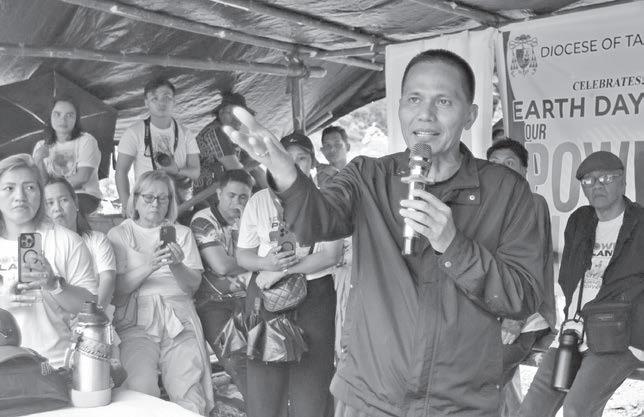
The bishop made the statement as a message during the interfaith and multi-sectoral event themed “Our Power, Our Planet,” on Palm Sunday, April 13, at a closed illegal mining site along the banks of upper Carac-an River in Barangay Lobo, the farthest community village in the town of Cantilan, to commemorate the 2025 Earth Day celebration ahead of its scheduled date.
Many good people are working in government, but it is difficult to be good if you are surrounded by people who are not, and therefore the call for us different sectors, even religious leaders and members of the church, is to provide an environment where we stand for
the truth; and to care for the environment will not be very difficult for them because they have us at their back,” said Bishop Dael. Dael added that he knows that standing with those in defense of the environment is not easy, especially when political parties often have differing views. But, he said, he admires those who are willing to risk political capital to show that the environment matters more than ambition.
This is the kind of leader we should vote for—those who think beyond themselves and act for the greater good,” he added. The bishop pointed out that they came to the area to see the significance of the place as Baran-
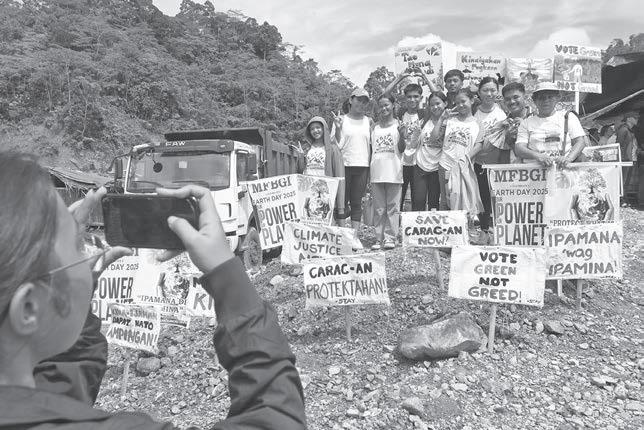


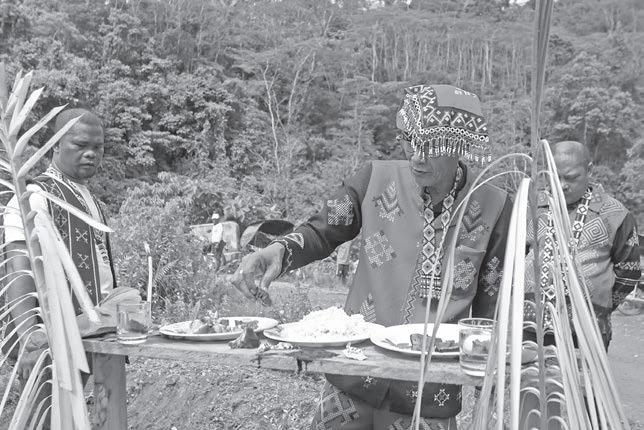

gay Lobo might be far from development, “but you are close to our hearts, as the place is alive with blessings from God teeming with nature’s abundance of beauty.”
In his speech, Bishop Dael also drew a contrast between the event and traditional political gatherings.
Most political events today come with handouts. You need to be fed or paid to show up. But here, we brought our food. We paid for our gas. There’s no debt of gratitude because an independent person cannot be bought,” he said.
Dael added that a free person has the courage to stand—no matter the heat, the cold, or the rain. This is the kind of commitment our people need, he added.
“If we can have leaders with this same conviction, imagine how far Surigao del Sur can go,” the bishop said.
Say no to illegal mining. Say yes to protecting our watersheds. That is our right—and that is our future,” Dael added.
The event was organized by the Diocese of Tandag’s Integral Ecology Ministry in collaboration with local groups and environmental advocates together with other Christian church leaders from the United Church of Christ in the Philippines (UCCP), and the Iglesia Filipina Independiente (IFI), also known as the Philippine Independent Church.
The event highlighted pressing environmental issues in Barangay Lobo, a critical area home
to Proclaimed Watershed Forest Reserves under Presidential Proclamation No. 1747.
Fr. Raymund Ambray, Director of the Integral Ecology Ministry, said the area is facing environmental degradation due to large-scale nickel mining, illegal small-scale gold mining, and rampant logging. These activities threaten local biodiversity, water sources, food security, and marine ecosystems due to sedimentation and laterite accumulation in nearby coastal areas.
“Rooted in the teachings of Pope Francis’s Laudato Si, the Diocese emphasized that environmental degradation is inseparable from social and moral crises. The Earth Day event aimed to raise awareness, promote ecological responsibility, and call for concrete actions from both government and communities,” said Ambray.
C antilan Water District General Manager Vicente Irriberi, one of the stakeholders who stated his support, said that environmental destruction affects everyone, especially when it comes to water security.
“Everything is connected to everything else. If there is life here, then our life in the town is also affected. If there is a problem with the water, it’s our problem.”
He warned that mining upstream inevitably affects the communities downstream.
“Everything must go somewhere. Everything has consequences. If there’s mining upstream, the dam-
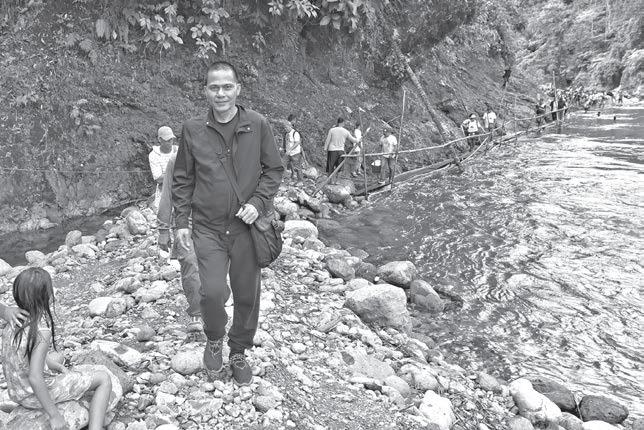
age will still reach us downstream. If mercury is washed into the river, and we use that same water to drink—we have a serious problem.”
Quoting basic ecological principles, Irriberi said, “Nature knows best. Don’t be surprised by nature’s retaliation. If there are storms, floods, and disasters, don’t blame nature. That’s our doing.”
He also gave a striking reflection on political accountability.
“ There’s no such thing as a free lunch. Nothing comes for free, especially now. Everything has a price. Even elections are expensive. Even choosing a leader comes at a cost. Think about what we receive in exchange. If you’re given money, expect that a return is expected. Whatever amount politicians hand out—there’s a price behind it.”
Irriberi shared that he brought
all employees of the Cantilan Water District to the celebration to affirm their stand.
“ Today, Cantilan Water District renews its commitment to protect our rivers, forests, and ecosystems not only as a utility provider but as a steward of life and sustainability,” he said. The Earth Day gathering was attended by a wide range of sectors including local government units, representatives from national government agencies such as the Department of Environment and Natural Resources, the National Commission on Indigenous People, the Department of the Interior and Local Government, the Department of Agriculture, the Bureau of Fisheries and Aquatic Resources, the Department of Education, civil society and advocacy groups.

By Alexander Lopez
UTUAN CITY—Demonstrat-
Bing its commitment to senior citizens, the Surigao City government has launched the Milestone Program of Distinction (MPD), providing a one-time P50,000 cash benefit to residents aged 90 to 99.
The initiative aligns with Republic Act No. 11982, also known as the Expanded Centenarians Act.
Ordinance No. 529-2024, the local legislation behind the MPD, earmarks the P50,000 financial assistance for each eligible nonagenarian residing in Surigao City.
Seventeen nonagenarians initially received their cash benefits on Monday.
The City Information Office said in a statement that a total of 152 nonagenarians have been identified as potential beneficiaries—34 verified in the first quarter and 19 with necessary documentation to claim their benefits.
“This program is a recognition of the invaluable contributions and enduring legacies of our senior citi-
zens who have played a vital role in shaping Surigao City,” the information office said.
The city government is actively encouraging families of nonagenarians who have not yet claimed the benefit to reach out to the City Social Welfare and Development Office for assistance with the documentation process.
According to the United Nations, the number of elderly Filipinos (aged 60 and above) is projected to increase to at least 10 percent of the total population between 2025 and 2030, marking the Philippines as an “aging society.” This means a significant shift in the age structure of the population, with a larger proportion of the population being older adults.
As the Philippines transitions to an aging society, it will need to address the unique needs of its aging population, including providing access to quality healthcare, social support, and ensuring the sustainability of social protection programs such as Surigao City’s Milestone Program of Distinction for its senior citizens. PNA
By Kanoko Matsuyama
EISAI Co.’s breakthrough Alzheimer’s drug Leqembi was cleared for use in the European Union, after the medicine was approved in the US and Japan. The European Commission approved the drug to treat adults diagnosed with mild cognitive impairment and dementia, Eisai said in a statement Wednesday.
The EU nod for Leqembi is significant, especially after the bloc withheld approval f or competitor Eli Lilly & Co.’s Kisunla last month.
The authorization for Eisai’s drug also known as lecanemab—the first medicine shown to slow progression of the mind-robbing disease— comes nearly two years after it was first cleared in the US as European regulators reexamined data on the drug’s safety. Lilly’s Kisunla failed to get backing from EMA’s drug advisory committee in March over risks of potentially fatal bleeding in the brain and is pending a final decision by the EC.
The stock rose as much as 4.6 percent in Tokyo trading Wednesday, the largest intraday gain since April 10. Alzheimer’s disease is the most
By Perla Lena
ILOILO CITY—A total of 65 elderly residents, including octogenarians, nonagenarians, and one centenarian from Lambunao municipality in Iloilo, recently received cash incentives through the Expanded Centenarians Act.
Lambunao Municipal Social Welfare and Development Officer (MSWDO) Althea Lacuesta, in an interview on Tuesday, said the recipients were those who turned 80, 85, 90, 95, and 100 years old during the first quarter of 2025.
Of the total numbers, 31 were 80 years old, 18 were 85 years old, six were 90, nine were 95, and one was a centenarian.
The octogenarians and nonagenarians received their P10,000 incentives each from the National Commission of Senior Citizens (NCSC) that visited the municipality to personally deliver the cash gift during the distribution at the Office of Senior Citizens Affairs (OSCA) on
April 11. The lone centenarian, Angelica Lebrilla Lozarita from Barangay Bagongbong, received P100,000 and a Letter of Felicitation from Malacañang.
“We still have more. We have 215 senior citizens from April to December,” Lacuesta said. Further, 96 others who turned octogenarians and nonagenarians since the law took effect last year are waiting for their cash incentives. Lacuesta said the incentives would have a great impact on the beneficiaries, recounting that others even cried when they received the amount as they intend to use the money to purchase their medicines, food, and other supplement.

“We told the folks that the incentive should be used for the food of the senior citizen,” she said. She said documents for target recipients are processed at the MSWD office and once complied with, the NCSC will set the date for the payout.
Lacuesta said the municipality has 10,601 registered senior citizens as of March 31 this year, including the 12 others who turned centenarians last year.
Old age is a time of resurrection

ONE day, a senior friend shocked me: “Why do you still want to be active? At our age, we’re practically dead and useless to society. Me? I’m just going through the motions of being alive and waiting for my resurrection on the other side.” I almost inadvertently spat out the coffee I was sipping.
I never bothered to answer back. He was too ensconced in his cynical self. Besides, it was futile to have a meaningful talk with his type. He always knew better.
common type of dementia and afflicts over 55 million people worldwide, according to Alzheimer’s Disease International.
Eisai’s drug is among the most potent of a new generation of antibodies that help clear amyloid, a toxic protein that slowly builds up in the brains of Alzheimer’s patients. In a large trial in 2022, patients administered Leqembi showed a 27 percent slower decline in cognitive abilities over 18 months than those given placebo treatment.
The drug gained full approval in the US, yet it carries stringent black box warning about the danger of swelling and bleeding in the brain called ARIA. Doctors must closely monitor patients and their response in a Centers for Medicare & Medicaid Services registry every six months for the first two years.
In March, the company lowered the global Leqembi forecast in March and said sales expected to reach ¥250 billion to ¥280 billion ($2 billion) for its fiscal 2027, citing delayed uptake in the US market and learning from launches in each region.
Eisai has set Leqembi’s price at $26,500
He was too self-absorbed to notice how beautiful the morning was, how good and heartening the coffee we were having, and the smiles on the faces of people who passed by our table.
I wanted to tell him, why wait for resurrection on the other side? At our age, every morning that we wake up is a resurrection moment. As Episcopal priest named Robert Morris tells us: “We all lie down. We all rise up. We do this every day.”

I’ve watched a video about people in Japan who are into a life without waste
By Alexander Lopez
UTUAN CITY—The Department of Social Welfare and Development in the Caraga Region (DSWD13) has reported the successful distribution of social pensions to indigent senior citizens during the first quarter of 2025. As of April 15, DSWD-13 said 178,818 indigent elderly have received their threemonth pension of P3,000
under the traditional philosophy of “MOTTAINAI,” which values cherishing the things we have. An inn is saved from ruin and transformed into a folk house. An old baby carriage repurposed as a planter for spring flowers. Worn-out uniforms become tote bags and pencil cases. Old newspapers are turned into shopping bags. Discarded desks and chairs upcycled into stylish and unique interior items. A classroom chair backrest made into a wall clock. And so on. The key message is “don’t throw old items, give it a new use.” It’s what I have been striving to do. Before throwing away anything, I think of another use for it to extend its life so it doesn’t end up in a landfill too soon or worse in an air polluting incinerator.
As seniors, why discard our use before our time to go? We need to re-invent, rebirth ourselves again if we want the bonus years given to us to be worthwhile. To do that, we must “kill” our old self, shed old habits one by one and put on a
totaling a substantial P536,454,000,” DSWD-13 said in a statement. Payouts for the second
new positive purpose in our lives.
One has to die to be born again. God Himself puts it this way: “I will give you a new heart and put a new spirit within you” (Ezekiel 36:26). From then on, He gives us a new purpose and new goals for living.
That’s the message that Easter brings to me. Resurrection does not have to do exclusively with what happens after we are buried or cremated. It does not have to do with that, but first of all it has to do with the way we live right now. For a true Christian or a good human being, resurrection unfolds in the quiet, ordinary moments of the present, grounded in the beauty and wonder of our earthly life.
In his book “The Three Secrets of Aging,” John Robinson writes: “Aging is an initiation into a new and extraordinary phase of life, a profound transformation of self and consciousness...”
As a senior, have you ever considered this as your time to emerge from the chrysalis of your life with a new-found passion to live your remaining years with creative and purposeful choices?
Instead of caving to a sense of being unwanted or un-useful, why not become aware of the life-enhancing benefits of unleashing our newborn self to bring more health, well-being and joy into our lives?
Lessen your focus on the externals of aging—finances, physical health practices, and retirement arrangements —but on the inner ones, such as the art of soulful living. It is a transitioning to being an elder with a renewed sense of purpose and leads on to a meaningful closing of life.
You can repurpose your life as “a program for bringing soul back to life.”
To paraphrase a pop song, a little bit of soul will wash away the tears of loneliness, melancholy, pain, helplessness and depression.
Spiritual writer Thomas Moore de-
quarter are underway in the province of Surigao del Norte. DSWD-13 also advised beneficiaries to coordinate their payout schedules with their respective Local Social Welfare and Development Offices.
“We also encourage them to communicate with the Office for Senior Citizens Affairs and chapter presidents in their localities for any inquiries or assistance,” DSWD-13 added. PNA
When asked about their secret to long life, Lacuesta said the beneficiaries attributed it to healthy living with a vegetable diet and without any vices.
Lacuesta added that aside from the benefits under the Expanded Centenarians Act, the municipality has 6,306 elderly residents who are indigent and receiving monthly social pension, while 1,309 others are on the waiting list. PNA
fines soul as “not a thing but a quality or dimension of experiencing life and ourselves. It has to do with depth, value, relatedness, heart and personal substance.” Without a well-nourished soul, it’s easy for a senior to descend into restlessness, addiction, insecurity, and frustration. For him, soul is the seat of the emotions and the hub of our lives. Moore claims that a loss of soul lies behind the restlessness, addiction, insecurity, and frustration experienced by many contemporary men and women. He argues that this loss of soul results in lives that are devoid of meaning and purpose, leading individuals to yearn for something that can nourish their souls.
Focus on resurrecting your relationship as husband and wife. In my case, I have made the decision to play a new role to my wife, who is suffering from severe arthritis of the knees. Physically limited in her ability to go out and walk, she has resigned herself to the wheelchair when we go out. I am her self-designated pusher and I love to do it for her whenever we go out to buy groceries or eat out. As part of my new re-purposed life, I have become a receiver, something that I was never comfortable with. I learned to appreciate the support from friends, family and the community on a much greater magnitude. I now realize that physical possessions, although they do hold importance and sentiment, can never share the same value as states of being: connection, love, happiness, fulfillment, gratitude, purpose. And I learned to be incredibly thankful to God.
Yes, we believe in life after death. But by renewing our inner selves again and again, through ordinary resurrections in the here and now, we can experience so much more in life even before the final bell.

Editor: Mike Policarpio
THE Department of Education (DepEd) recently opened consultations to the general public and private stakeholders on the updated curriculum guides (CG) for Grades 11 and 12.
This complies with the directives of Pres. Ferdinand R. Marcos Jr. in ensuring quality education and employability of senior-high school (SHS) graduates.
In a statement, the DepEd said the result of public consultation will be “reviewed and integrated” into the final framework of the SHS curriculum.
“Consultations [were opened] to the general public, including teachers, learners, parents and industry representatives,” the de -
FILIPINOS are increasingly demonstrating a strong willingness to embrace opportunities for global learning.
According to the “Open Doors 2024 Report on International Educational Exchange,” more than 4,000 Filipinos decided to pursue their higher education in the United States in Academic Year 2023-2024—up by almost 17 percent compared to the previous period. The growth suggests not just of Filipinos’ interest in global learning, but also reveals the strong educational ties between the Philippines and the US. Parallel to this growth is an opportunity that allows a student to benefit from global learning without leaving home through transnational education (TNE). It is defined by the United Nations Educational, Scientific and Cultural Office or UNESCO under “International Higher Education (IHE)” as “higher education programs where students are based in one country, while the institution offering the program is located in another.”
In collaboration with Arizona State University (ASU), Mapúa University’s E.T. Yuchengco School of Business, School of Health Sciences, School of Nursing, and School of Medicine are enhancing access for Filipino students to high-quality international education. This initiative emphasizes global immersion, real-world experiential learning, enhanced learning through advanced and immersive facilities, and the mastery of digital skills.
The opportunity to engage in TNE is pertinent not only to students, but also to their parents. In today’s landscape where the younger generation
INSTRUCTURE, the creator of
partment said. Under the updated CG, core subjects were reduced from 15 to five, with new ones including Effective Communication, Life Skills, General Mathematics, General Science, and Pag-aaral ng Kasaysayan at Lipunang Pilipino alongside time allocation, were also adjusted for the mastery of “essential competencies.”
According to DepEd, “the updated core SHS subjects are designed to deepen learners’ foundational

competencies in communication, scientific and mathematical thinking, [as well as personal development to better] prepare them for lifelong learning and active civic participation.”
The updated SHS CG also organized elective subjects into clusters which learners can choose from, in -

often makes informed choices independently, Filipino parents remain significantly involved in determining the educational paths of their children. The decision-making process on higher education is a key aspect of familial culture in the Philippines, which highlights the importance of collaboration between parents and students in navigating these essential choices.
“[Our linkage with Mapua on business and health sciences can serve as] a reference point for TNE,” ASU’s vice president for Global Academic Initiatives Julia Rosen said. A highlight of the linkage is the introduction of degree pathway programs between the E.T. Yuchengco School of Business at Mapúa and ASU. This initiative enables students to earn degrees from both universities. Mapúa students have the option to finish their studies online or attend classes at the latter’s campus in the US.
“Through our degree pathway programs [with the E.T. Yuchengco School of Business at Mapúa], students can earn two degrees from two outstanding institutions in just four years,”
Rosen said. “It’s [efficient] for students to open their career horizons, whether they stay in the Philippines, whether they work in America or anywhere else.”
She added that “America is still a hub, if not THE hub, for technology, innovation and global trends. ASU, within that environment, is the most innovative public university. I would say, in terms of preparing your child for long-term success, it would make sense to send them to the hub of innovation in America…I believe that is a distinguishing characteristic that other models might not be able to replicate.”
The ASU executive also thinks that it is advantageous for parents and students alike to consider transnational education, especially its pathway programs that offers financial accessibility and high quality of learning.
The collaboration also offers Optional Practical Training that gives students the opportunities to gain up to 3 years of US work experience, which enables learners to have realworld experiences overseas, enhances their employability and widens their professional network locally and globally.
stead of taking fixed subjects under their strands.
The agency previously held stakeholder engagements that discussed proposed features of the updated SHS curriculum with more than 2,000 participants in 14 regions nationwide from January to February. By Stephanie Sevillano/PNA
The institution recognizes that pathway programs can be expensive, but it is finding ways to provide offerings in short-term experiences such as the “ASU Summer Immersion,” so that they remain accessible to students.
Overall, the future graduates of Mapúa University business and health sciences programs benefit from its linkage with ASU, as they are assured of acquiring global and innovative skills needed for the modern industries and workplaces.
“By the time our students graduate, they will have been exposed to applied projects,” Rosen confirmed. “They would have understood how to work in teams and work with people that come from different disciplines. They have curriculum that is based on real world challenges—all of that collectively might be called ‘soft skills,’ and that is the competitive advantage.”
“Building a global university network grounded in providing access to students to unparalleled global opportunities, this whole collaboration…is unique in the global marketplace. [What we are doing is also replicated in 29 other universities across the globe. Mapúa also is working directly with universities in Malaysia, in Mexico, in Ecuador and others, so it is being internationalized by its membership in the network, in addition to the ASU connection]. To my knowledge, no one else is building a network of this scale and scope,” the ASU executive shared.
“Again, [this is] grounded in the fundamental values of providing new global education opportunities for students, and also transforming the regions where the students live,” she concluded.
Charting
THE University of Asia and the Pacific (UA&P) recently announced the appointment of Atty. John Philip R. Yeung as its fifth president effective August 18, 2025.
A UA&P alumnus, Atty. Yeung brings a dynamic blend of experience in law, entrepreneurship, education and public service. He earned his Humanities degree with a Professional Certificate in Political Economy from UA&P in 2005. Thereafter, he obtained his Master’s in Entrepreneurship, then his Juris Doctor degree.
From managing his family’s pharmaceutical business to establishing ventures in real estate, food service, finance and information technology, Atty. Yeung has demonstrated a keen entrepreneurial spirit. He founded the Yeung Law Office which specializes in property litigation while upholding ethical business practices.
In 2023, he was elected barangay councilor of Ayala Alabang, where he was an advocate for community safety and governance reforms. A dedicated family man, he has actively championed pro-family initiatives through Educhild Foundation. Atty. Yeung is no stranger to UA&P’s academic community, where he had previously taught Media Law and Entrepreneurial Marketing. He is also a faculty member at San Beda College-Alabang and the UA&P Institute of Law, where he teaches Constitutional Law, Local Government Law, and Property Law. As he steps into his new role, Atty. Yeung is poised to lead UA&P

into a new era of growth, innovation and academic excellence, while strengthening its Christian identity and mission to nurture future leaders committed to integrity and service.
The university also expresses profound gratitude to its current president Dr. Winston Conrad B. Padojinog for a decade of dedicated leadership. His tenure saw UA&P through key milestones such as academic program expansions, digital transformation, infrastructure development and sustained financial stability—all while securing UA&P’s place in global rankings and shaping its “Strategic Vision 2030.” Dr. Padojinog will continue serving as president of the Center for Research and Communication Foundation Inc. to further support UA&P’s research and executive education initiatives.
Atty. Yeung will officially assume the UA&P presidency during the “University Opening Rites” in August.

THE Philippines’ leading fiber broadband Converge ICT Solutions Inc. has further strengthened its presence in Iloilo by collaborating with Central Philippine University (CPU) to elevate the educational experience through world-class connectivity and technological innovation.
LMS being used by top Philippine universities, was named to the prestigious “2025 GSV 150.” This coveted list, compiled by Global Silicon Valley (GSV), highlights the 150 most transformational growth companies in digital learning a nd workforce skills shaping the future of education worldwide. Selected from more than 2,500 global companies, the GSV 150 list recognizes companies making significant contributions and innovative solutions that enhance learning outcomes, drive educational accessibility and equip learners globally with essential 21st-Century skills. For the selection process, GSV evaluated companies across five key factors: revenue scale, revenue growth, user reach, geographic diversification and margin profile. The 2025 cohort of the GSV 150 collectively reaches 3 billion learners and generates over $25 billion in annual revenue.
er is ready for the next stage of the learning journey.”
“We are honored to be recognized as a transformational company in this year’s GSV 150,” said Instructure CEO Steve Daly. “This acknowledgment reflects our commitment to reimagining the technologies that turn teaching and learning into opportunities. As the education landscape evolves, we are focused on ensuring the learn -
Selection to the GSV 150 highlights companies demonstrating strong growth potential, scalability and the capacity to positively impact the future of learning and work. Instructure’s inclusion coincides with its participation in the “ASU+GSV Summit” in April—an event focused on innovation in education. In addition, GSV honored two Instructure employees as “2025 Leading Women in AI,” as Chief Academic Officer Melissa Loble and Principal Artificial Intelligence Product Manager Narine Hall at Instructure were recognized. This honor shined the
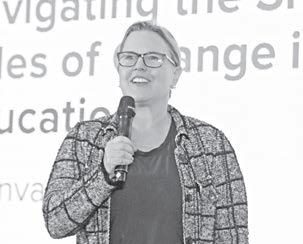
Founded in 1905, the university is one of the premier academic institutions in the Visayas, renowned for its distinguished programs in engineering, business, health sciences, and education. It seamlessly combines academic excellence with Christian principles, fostering the intellectual, moral, and spiritual development of its students. With a steadfast commitment to strengthening faith and advancing scholarship, research, and community service, CPU continues to cultivate future leaders equipped to make a meaningful impact in their fields and in society.
The collaboration marks a significant milestone in Converge’s Iloilo expansion through worldclass digital infrastructure to CPU students and faculty. By deploying high-speed fiber broadband, the technology-solutions provider is empowering the CPU community in an increasingly digital landscape.
“At Converge, we are committed to empowering educational institutions like CPU with digital tools they need to thrive. As a key province in our digital development strategy, Iloilo plays a crucial role in our mission [of providing] reliable,
high-speed fiber connectivity and innovative technology solutions,” said Converge’s assistant vice president and Visayas-Mindanao head of Enterprise Maria Asuncion Canen. “By equipping universities with the necessary digital infrastructure, we ensure they remain leaders in shaping the future of education in a rapidly advancing landscape.” By harnessing Converge’s leadership in fiber broadband and worldclass technology, CPU is strategically positioned to incorporate cutting-edge innovations such as artificial intelligence or AI and the Internet of Things or IoT, thereby advancing both the academic experience and future opportunities.
CPU president Dr. Ernest Howard Dagohoy expressed his enthusiasm about the collaboration: “We are thrilled to work with Converge—a company that shares our vision for innovation and our commitment to the future of education. This initiative will support our ongoing efforts to provide our students with an education that integrates the best of technology and Christian values, empowering them to become leaders and innovators.”
The alliance strengthens CPU’s ongoing pursuit of academic excellence and innovation, ensuring the university can effectively meet the evolving needs of its students and faculty. With Converge’s robust digital infrastructure, CPU enhances its operational efficiency, while creating a more dynamic learning environment.
Tourism Editor: Edwin P. Sallan




TIME off from our daily grind is sweeter during national holidays including Holy Week. It’s because most everyone else at work is offline— reducing the guilt (and paranoia) you feel from not being available.
The usual quick win people from the metro think of when they have a day are destinations in Tagaytay City. But let’s face it: You might be driving southward for three hours before that breakfast or lunch and coffee, then spend another three hours in traffic because everyone is headed back to Metro Manila, too.
The past years changed that notion for my husband and I. Events such as the staging of the Toyota Gazoo Racing Philippine Cup at the Clark International Speedway in Angeles, Pampanga and drives for auto brands like Jetour Philippines have brought us north quite a number of times. But now, we find ourselves driving up north on our own volition because of our many discoveries in the freeport zones of Clark and Subic. Our threehour drives to Tagaytay have been supplanted with less than two hours spent on NLEX to get to destinations we have come to love. We always search for churches in new places. A trip last year led us to the Immaculate Conception Parish in Balibago, Angeles City after around 15 minutes on the road from Clark. The church was built in 1965 on a land donated by husband and wife Teodoro Tinio and Maria S. Valdes. Through an open side entrance and accommodating church hands, we were able to enter the parish. Inside the spacious church, light comes in from everywhere, including the stained-glass windows near the ceiling. A crucified Christ is at the center of the altar that is made grander by touches of gold and wood. The silence in holy places like this is so inviting for prayer and reflection. You are not in a rush; spend some quiet time praying to your favorite saints, and just take the solemnity of the place in. We sat there for about an hour imagining just how many people fill the church during masses and holy days. Pampanga is home to many churches and the less popular ones can be the place of reflection and
Supetran
THERE was a time when Marinduque was merely known for “Moriones Festival”, one of the country’s oldest and most-anticipated Holy Week observance.
Known locally as “Moryonan,” it is so called because of the “moryon” devotees or Roman soldiers which roam around the streets to lend the ambiance of the place and time of the Lord Jesus Christ’s crucifixion.
Just like the iconic masks which have captured the fancy of even jaded travelers, Marinduque is a magical island province which has been shrouded by an aura of mystery. And to reveal its shining countenance, we need to unmask it for all and sundry to admire.
That’s exactly what the provincial government did in the recent 105th reestablishment anniversary after being part of its bigger neighboring provinces.
The four-day event, which was as a coming-out party of sort, put to the fore Marinduque’s innate charm with a bevy of activities to promote it as a year-round destination and not just a Lenten hideaway.
Spicing up the celebration is the float parade which featured the province’s touristic landmarks and the vi -
brant Festival of Festivals where the six towns put their best feet forward in the street dance competition.
Marinduque congressman Lord Allan Jay Velasco said that the festivities put the spotlight on the province’s natural wonders, diverse attractions, and checkered history which can make the island the next tourist hotspot.
A motorsports enthusiast, he noted that the island is an emerging haven for motorcycle riders, bikers and four-wheel drivers because of its panoramic countryside and splendid roads. And for this reason, he minted the PusoMoto, a motoring loop adventure which has become the province’s newest tourism product. The recent anniversary brought in 140 enthusiasts who zipped a 140-km joy ride on scenic roads, pitstops and immersive activities.
“Every motoring journey or every loop starts from the heart of the archipelago, and we can surely give visitors a heartwarming experience and a heartfelt hospitality,” Velasco enthused.
The island has dubbed itself the “Heart of the Philippines” by virtue of being the geodetic center of the archipelago as mapped in the Luzon Datum of 1911 located at an observatory in Mogpog. A must-see spot, the landscaped and wind-swept mountain

pause you are looking for.
We have also discovered many places to stay in Clark and Subic, thanks to the brands who have hosted us. These hotels or resorts have made lasting impressions. We have returned on our own to mark special occasions. In Clark, Swissotel Clark tops our list for several reasons. The rooms (including bathrooms) are spacious, the view is exceptional, and the food offerings are hard to match. The rooms at this hotel offer guests a contemporary look and feel, with room options available for big groups. Extra beds can be arranged upon reservation, too. It’s hard to get yourself out not only of the rooms but also the hotel itself. There are plenty of dining options offered by the hotel, including the generous breakfast buffet spread at Markt, exquisite Italian food at Ristorante Di Verona, and irresistible ice cream served by Oma’s at the lobby. There are branded

restaurants as well at the lobby area for you to choose from. The infinity pool provides a view of the Zambales Mountain Range, and guests can enjoy drinks and snacks from the Pool Bar in between dips. Swissotel is strategically located on the Manuel A. Roxas Highway, so you see a lot of guests enjoying morning walks or taking their bikes out for a spin before reuniting with their loved ones.
Since you are in Clark already, what’s another hour of driving to head to Subic? We hit the road for a scenic jaunt along the Subic-ClarkTarlac Expressway (SCTEX) to head to the ACEA Subic Beach Resort along San Bernardino Road in the Subic Bay Freeport Zone. The resort offers a beautiful view of the ocean and Mt. Zinco Pincos via its private beach front and infinity pool. The view alone captivates any first-time visitor, especially if enjoyed at the terrace of your own rooms. We always


park provides a breathtaking vista of Balanacan Cove and the province’s eastern coast. White beach-crazed travelers can revel at Marinduque’s alluring coastline and idyllic isles, such as Tres Reyes Islands, Polo, Mompong, Palad Sandbar and Maniwaya. The latter is the province’s eastern backdoor where visitors from Quezon’s Bondoc Peninsula towns enter onboard an outrigger boat.
look forward to being in the pool or by the beach during sunset.
The place transforms at night, with live acoustic music serenading guests on some nights at the Sunset Bar by Salt. You can literally choose your own adventure. Enjoy the music while taking a dip at the infinity pool or dining with the beach front and fresh breeze keeping you company.
Recommended dishes at the Sunset Bar by Salt include their pork sisig, beef sinigang, and a serving of halohalo or mais con yelo. There is a wide selection of Filipino, Western, Continental, and Spanish dishes – aside from cocktails and refreshments to enjoy. Sitting outside truly tells your mind and body that it’s time to disconnect and be fully present in the moment.
Mornings at ACEA start with breakfast at the Salt + Bar Restaurant and a picturesque view of the resort and nature on its terrace, if


you want to dine al fresco. We always like starting early because we have a few hours to either swim or sit by the beach again before we drive home. Guests on jet skis usually join the morning scenery. We prefer just taking it all in from our room’s terrace with a serving of iced coffee from the resort’s View Cafe. If you’re worried about not getting a proper caffeine dose before checking out, they can easily solve that for you. So, consider going north for a change to our freeport zones in the area. If you have not visited for some time, the transformation can surprise you. There are many cafes to choose from, dining stops offering Pampanga cuisine and international dishes, historical stops, and wide spaces to clear your mind and unwind. We wouldn’t blame you if you choose to go beyond the usual and go further north soon after. In fact, we encourage you to do so.


Poctoy Beach in Torrijos boasts of a long stretch of fine sand and crystal-clear water, a dive and aquasports shop, and the posh Amara Resort and Beach Villas. Beneath the sea, it has a gallery of moryon statues and
coral gardens ideal for scuba diving. Natural wonders which shouldn’t be missed are its series of caves and waterfalls, the Malbog Sulfuric Hot Springs, the biodiversity-rich Mt. Malindig, and butterfly gardens which have earned the province the title of being the country’s “butterfly capital.” It is also a treasure trove of customs and traditions, most notably the “putong” ceremony which townsfolk accord to guests through a song and dance serenade, culminating with the crowning ritual and the showering of leaves. The provincial capital














More local companies to deploy CRM solutions as part of digital transformation
BY RIZAL RAOUL REYES















AT two in the morning, most homes in the city are still and silent. The traffic has slowed to a murmur, and the lights of 24/7 convenience stores glow quietly on street corners. But for someone like Carlo, a 22-year-old working student at a call center, the day is far from over. After ending his shift, he makes a quick instant coffee, opens his laptop, and logs into his online class platform to pick up where he left off—reviewing a case study on digital marketing. He knows he won’t get much sleep, but he’s used to that. He’s chasing a future that doesn’t leave much time to rest.
Carlo isn’t real, but his story mirrors the lives of many working students across the Philippines— young people navigating long shifts, full course loads, and the pressure to keep moving forward even when the odds are stacked against them. It’s a quiet hustle that unfolds across thousands of homes, boarding houses, and dorm rooms. Most people don’t see it. But it’s happening. And on March 21, 2025, the country finally paid attention.
NATIONAL WORKING STUDENTS DAY
THE Philippines marked the first-ever National Working Students Day, a movement led by Mapúa Malayan Digital College (MMDC), the country’s premier digital-first college. The day was established to honor the extraordinary efforts of students who juggle work and school—often out of necessity, always with a remarkable degree of discipline and determination. More than a celebration, it was a recognition of an overlooked sector of society. And more than recognition, it was a call to action.
Working students live in a constant state of compromise—balancing schedules, responsibilities, energy, and ambition. It’s not simply about time management; it’s about making education work in a life already full of commitments. For many, education is not just a goal but a lifeline—a way to rise above economic hardship, secure better jobs, and build stability for their families.
This complex reality has long been central to MMDC’s advocacy through its Step Up sa Pangarap movement, which aims to empower working students not only to finish school but to advance their careers, finances, and lives. MMDC, a college under Mapúa Malayan Colleges Laguna, created National Working Students Day to elevate their stories and encourage institutions to design better systems around them.
TO better understand the challenges working students face, MMDC partnered with data forensics company Nerve to conduct a nationwide survey. The findings, presented during the National Working Students Day media launch, revealed that 56 percent of respondents identified lack of time as a major challenge in balancing work and studies. Seventy-five percent said they needed more flexible schedules, while 52 percent cited online or hybrid learning as a crucial form of support. Perhaps most striking was that 86 percent expressed a strong desire to upskill—clear evidence that these students are eager to improve their circumstances, if only they had the tools and time to do so.
Jenny Chua, vice president at MMDC, emphasized the college’s role in addressing these needs. “MMDC has been addressing the challenges of working students through our student-focused and modern BS Information Technology programs, which equip them with workforce-ready skills highly sought-after in both global and local job markets,” she said. “Our core curriculum is complemented by online learning
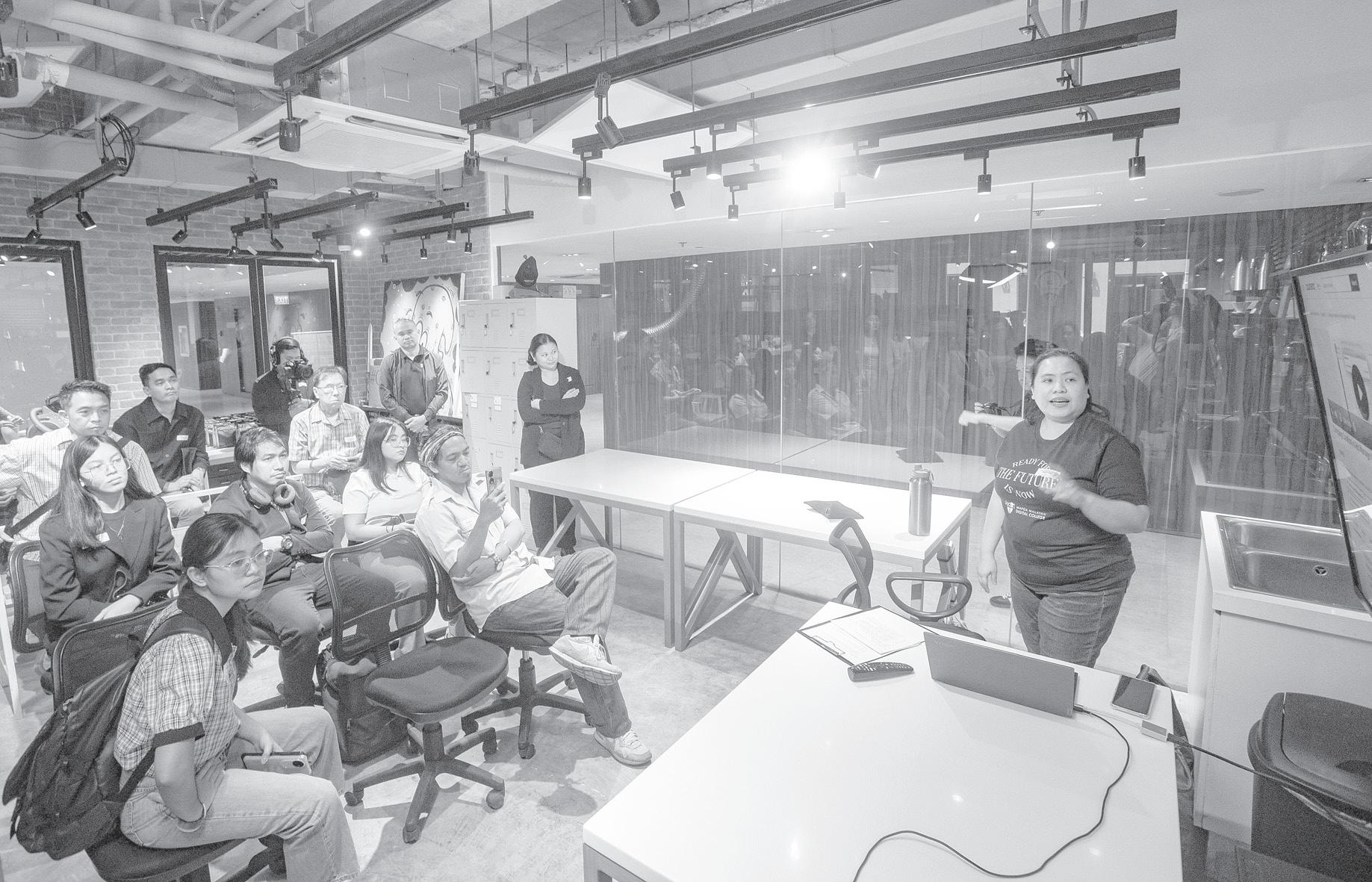
accessibility and practical support.”
Mapúa Malayan Digital College was built with a clear mission: to serve students who need more than classrooms and chalkboards. The college blends academic rigor with accessibility, using digital tools to create a learning environment that adapts to its students’ lives. At the heart of MMDC’s model is its project-based learning approach. Rather than rely on traditional exams, students engage with real-world scenarios through the Projects, Problems and Cases (PPC) method. This framework focuses on practical understanding and skill development—essential for job-readiness.
To support students who need to study outside conventional class hours, MMDC integrated AIpowered features into its platform, including AI Coach and AI Dialogue. These tools help learners navigate coursework, reinforce learning, and access curated global content from leading institutions. Combined with guidance from academic coaches and industry professionals, this learning model offers both structure and adaptability—two things working students need the most.
AS part of its celebration of National Working Students Day, MMDC also launched the Career Leap Pad, a collection of affordable, fully online certification programs designed to help students and professionals build relevant skills quickly. The courses—delivered through Coursera’s platform— cover high-growth areas such as Google Digital
Meta Social Media Marketing, Adobe Content Creation, and Virtual Assistance. Open to non-degree holders and priced between ₱5,000 and ₱9,000, these microcredential programs can be completed in just a few months. More importantly, they come with career support features such as résumé development, interview coaching, and job-matching guidance, making them a powerful stepping stone for those eager to improve their employment prospects.
Support for working students extends beyond the classroom. Recognizing that systemic change requires a collaborative effort, MMDC has built a strong network of partners across industry, government, and the academe. Organizations such as McDonald’s Philippines, 7-Eleven, RCBC, Microsoft, Concentrix, Sutherland, iQor, Everise, Genpact, the Negros Occidental Provincial Government, the Contact Center Association of the Philippines (CCAP), the IT & Business Process Association of the Philippines (IBPAP), and Rappler are working with MMDC to create more inclusive pathways for working students. These partnerships provide flexible job arrangements, scholarships, internship opportunities, and continuing education programs tailored to the needs of those who balance employment and study.
These collaborations were highlighted during the National Working Students Day media event, where MMDC hosted a panel titled Filling in the Gaps: What Organizations are Doing to Support Working Students. Adi Hernandez, assistant vice president of McDonald’s Philippines, shared how their partnership
continue their education without sacrificing their jobs. “Flexible work hours and strategic branch assignments help remove barriers for employees pursuing their studies,” she said.
TV host and education advocate Bianca Gonzalez reflected on the pace of change in today’s workforce and emphasized the importance of lifelong learning.
“The jobs five years from now don’t even exist yet. If we don’t learn more, we’ll be left behind,” she said, expressing support for MMDC’s Career Leap Pad as a forward-thinking approach to upskilling.
The first National Working Students Day marked a cultural shift. For the first time, the country formally acknowledged a growing student population whose academic paths are shaped by work obligations and economic responsibilities. These learners are no longer outliers. They are central to the future of education. Celebrating their achievements sent a powerful message: their goals matter, their struggles are real, and their determination deserves institutional support. It also reminded schools, employers and policymakers that educational success doesn’t belong solely to full-time students on a linear path. Many now work by day, study by night, and support entire households along the way.
In the Philippines, where education is often seen as the clearest path to a better future, supporting working students is more than an act of recognition. It is a national investment. Because when learners are no longer forced to choose between earning and learning, and when systems are built to support—not just applaud—their effort, everyone moves forward. ■
Nintendo’s ‘paid tutorial’ confuses the gaming community
BY PATRICK VILLANUEVA
NINTENDO, home of Pokémon and Super Mario, made a decision that baffled the entire gaming community: making the tutorial for their latest Nintendo Switch 2 become a playable game that users have to buy.
Announced during Nintendo Direct, a special livestream for news and development around Nintendo, viewers were introduced to Nintendo Switch 2 Welcome Tour, a paid digital-only game that was supposed to teach the users about the ins and outs of the console.
Presented by Nintendo Switch 2 producer Kouichi Kawamoto, he explained that users can explore a digitalized world of the machine. Players can then click around and learn about the mechanics that can be found in Nintendo Switch 2. “Some of the secrets ranged from the unique
features of the system to tiny details you might not notice until they’re pointed out,” Kawamoto mentioned.
However, the controversy of the announcement occurred when it was announced in the livestream that the demo would come with a price.
“Nintendo Switch 2 Welcome Tour will launch as a paid digital game on the same day as Nintendo Switch 2,” Kawamoto said right before the end of his presentation.
This sparked discussions online as the fans were confused as to why they needed to pay to learn how use a product they will, presumably, buy.
Under the YouTube comments in the video, one user said, “First time seeing the tutorial of a device being sold separately.”
Another commented: “The ‘welcome tour’ [aka: instruction manual] being a paid game is some unhinged behavior even for Nintendo.”
A Reddit thread started a discussion about the topic and the community pointed out how this is simply “greedy” from the company.
A user commented: “Damn Nintendo [nickel] and dim[e]ing its fan base amid high prices in our current economy....” Another commenter said: “It doesn’t matter that it’s ‘only’ $10.... Tech demos should be included with the base console, period. The problem isn’t what they’re charging—it’s that they’re charging.”
“This is a prime example of what marketing folks call ‘categorical change.’ Consumers adjust to price changes, but charging even a little for something that should be free is much more offensive,” he added. Users under the thread shared the sentiment that this should be free.
The price was revealed with an internet and media company that covers video games and entertainment media. It is said to be at $9.99.

FILIPINOS suffering from brain and mental health conditions may soon benefit from improved diagnosis and treatment options.
Thanks to the Department of Science and Technology’s (DOST) Neuroimaging Technologies for Improved Diagnosis and Treatment of Neurological and Neuropsychiatric Conditions in the Philippines (Neuromap PH) project that introduces innovative brain imaging technologies for earlier and more accurate detection of neurological and neuropsychiatric disorders, including Alzheimer’s disease and dementia.
Neuromap PH, implemented by the St. Luke’s Medical Center, is the first project in the Philippines to integrate multimodal imaging systems.
These systems combine structural-functional magnetic resonance imaging, diffusion tensor imaging, and positron emission tomography.
These imaging systems help clinicians identify early markers of conditions such as Alzheimer’s disease and frontotemporal dementia, which often go undiagnosed due to the current lack of specialized diagnostic tools.
A population-based study revealed that 10.6 percent of elderly Filipinos have undiagnosed dementia or Alzheimer’s disease, leading to delayed care and preventable deaths.
Alzheimer’s accounts for 85.5 percent of dementia cases among Filipinos aged 60 and above, with projections indicating a surge in dementia diagnoses, potentially reaching 1.5 million by 2030 and 2.5 million by 2050.
Despite the rising elderly population and growing dementia cases, no local effort has integrated imaging modalities to detect neurodegenerative diseases until now.
“With the neuroimaging bio -
bank, I am positive that this will open more doors to more comprehensive R&D efforts and better diagnostic methods,” said DOSTPCHRD Executive Director Dr. Jaime C. Montoya, reaffirming the Council’s commitment to strengthening brain and mental health research.
Funded with P60 million by the DOST-Philippine Council for Health Research and Development (PCHRD), Neuromap PH aims to strengthen the country’s capacity for early detection and management of neurological conditions.
The project also seeks to establish a scalable neuroimaging biobank, supporting the development of localized diagnostic protocols and promoting ongoing research in brain and mental health.

“We, at DOST, are invested in providing solutions to a more comprehensive and collaborative approach in developing technologies to assess and allow early detection for Neurological and Neuropsychiatric Conditions,” said Science Secretary Renato U. Solidum Jr.
“Through projects like Neuromap PH, we open opportunities for stronger partnerships with experts overseas to strengthen our local research capacity. We hope to build the necessary infrastructure and enhance the skills of our local experts in creating effective treatment strategies for brain and mental health conditions in the country,” Solidum added.
The project envisions establishing a Brain Mapping Center, a dedicated facility for advancing research, diagnostics, and unified management of neurological diseases.
Through evidence-based strategies, this center will further contribute to the effective implementation of Republic Act 11036 or the Mental Health Law.
While the project is ongoing and locally led by Filipino researchers, Neuromap PH benefits from technical support through its partnership with the Brain and Mind Research Center of Nagoya University in Japan.
Japanese researchers assist in refining protocols for image acquisition and analysis while training local researchers in advanced neuroimaging methods, further enhancing the project’s capacity to meet the country’s growing neurological health needs.
SCIENCE Secretary Renato U. Solidum Jr. encouraged students from the Philippine Science High School (PSHS) to apply and share their knowledge to uplift lives and improve communities in Geographically Isolated and Disadvantaged Areas.
During a recent visit to the PSHS-Mimaropa (Mindoro, Marinduque, Romblon and Palawan) campus in Odiongan, Romblon, Solidum emphasized that what distinguishes graduates of Pisay, as PSHS is also called, is their commitment to giving back, serving others, and fostering innovation.
“At the DOST, we want to nurture this spirit,” Solidum pointed out.
“That’s why we created the Technopreneurship Program to help young innovators like you to become your own boss.” Solidum, who also hails from Odiongan, Romblon, pointed out the need to cultivate a culture of innovation and entrepreneurship— “where your ideas can grow into solutions, and solutions into sustainable enterprises.”
He also encouraged the students in Mimaropa to reach out to the DOST Provincial Science and Technology Office and collaborate through the Innovation Hub (iHub), and pursue their ideas and turn them into products and services.
“For true innovation to thrive, and for meaningful startups to emerge, three things must work hand in hand: education, infrastructure, and opportunity. And among these, education is the most crucial. Once we strengthen education, everything else
follows,” said Sec. Solidum. iHub for student-researchers
AN innovation hub is set to be established in Odiongan, Romblon, in support of a new initiative.
In an interview during the Kapihan sa PIA (Philippine Information Agency) Romblon two months ago, Mae Angelica Famini, the Science and Technology Officer of the Provincial Science and Technology Office (PSTORomblon), shared that the DOST is drafting plans for the iHub to assist student-researchers and

It was the 11th human spaceflight for the Washington state-based company, founded by Bezos in 2000 after making a fortune with Amazon.
Bezos strapped in for Blue Origin’s first space tourist flight in 2021 and accompanied the latest crew to the pad.
Flynn; Aisha Bowe, a former NASA engineer who started her own companies to promote science education; and Amanda Nguyen, a scientist who studied planets around other stars and now advocates for survivors of sexual violence. Blue Origin declined to say how much the flight cost or who paid what. The trip came two months before Sanchez and Bezos marry in Venice.
The celebrity launch was the nation’s first spaceflight where women filled each seat. The only other all-female crew in 64 years of human spaceflight was back in 1963. That’s when Soviet cosmonaut Valentina Tereshkova launched by herself, becoming the first woman in space. Tereshkova spent three days off the planet. Even after the latest launch, women
PHL innovators win 5 medals in Geneva 2025
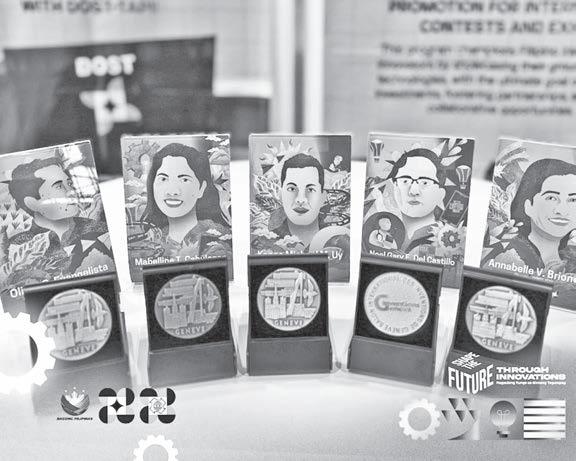
GENEVA, Switzerland—Filipino inventors have achieved significant success, securing multiple prestigious awards, at the 50th International Exhibition of Inventions Geneva (IEIG) held from April 9 to 13.
The Philippine delegation is bringing home one gold, three silver, and one bronze medals for their innovative technologies. This accomplishment highlights the Philippines’ growing strength in developing solutions for global challenges. The winning inventions, supported by the Department of Science and Technology-Technology Application and Promotion Institute (DOST-TAPI)’s Science and Technology Promotion for International Contest and Exhibits (SPICE) Program, are the following:
Gold winner
THE Gold Award was received by the invention, “A System and Method for Managing Healthcare Services and Networks,” by Noel Gary del Castillo, CEO and Founder of SeeYouDoc Corp. The invention revolutionizes healthcare access by integrating telemedicine, scheduling, e-prescriptions, and payments, connecting patients and providers seamlessly for enhanced healthcare management.
Silver medal winners
n The DOST-Industrial Technology Development Institute’s (DOST-ITDI) Continuous Screw Type Salt Washer, was represented by its Director Dr. Annabelle Briones.
An innovative mobile system that transforms raw salt into highpurity products directly at the production site, it significantly reduces processing time, steps, and costs for local communities.
innovators from Romblon.
The iHub will function as a co-working space where students and researchers can access the internet and use various gadgets to develop their ideas. They will also receive mentorship from experts who will guide them in refining their projects and innovations.
The hub is expected to be operational at the DOST Mimaropa PSTO in Odiongan.
Notable iHubs in other regions include those in Kalinga, Zamboanga del Norte, and Guimaras, each designed to address local innovation needs and promote inclusive economic development through public-private partnerships.
Additionally, Solidum visited the construction site for the new Academic Building 2, which is planned to include additional classrooms and state-of-the-art laboratories.
The new hub is inspired by the DOST logo, featuring four interconnected circular segments that reflect the iconic DOST emblem.
Allan Mauro V. Marfal/S&T Media Service
represent barely 15 percent of the more than 700 people who have traveled into space. Sanchez said she deliberately chose women to launch with her, each of them eager to inspire both the young and old to dream big, and even commissioned special flight suits.
The launch brought out VIPs to West Texas, including Oprah Winfrey; Kris Jenner and other members of the Kardashian family; former NASA astronaut Mae Jemison, who became the first Black woman in space in 1992; and several women who previously have flown on private flights. Winfrey, a close friend of King, wiped away tears when the capsule reached space and the passengers were heard marveling
n The Three-in-One Mobile Salt Crusher, Washer and Harvester Equipment, also from the DOST-ITDI represented by Oliver Evangelista, is an efficient and affordable technology that effectively removes impurities from salt, and consistently meeting the stringent purity levels required by the food industry.
n The “Earth Board: Coir-reinforced Bio-Based High-Density Polyurethane Composite for Structural Panels” project was represented by Kenno Michael Uy, CEO and Founder of Lesstics Inc.
This eco-friendly material, expertly crafted from coconut coir, offers superior insulation, strength, and moisture resistance, presenting a compelling green alternative to traditional construction materials.
Bronze medal winner
THE Bronze Award was given to “HazardHunterPH: Systems and Methods in Conducting Multiple Single Hazard Assessment, represented by Mabelline Cahulogan of the Philippine Institute of Volcanology and Seismology of the DOST (DOST-Phivolcs).
This user-friendly tool provides instant hazard maps and comprehensive analysis for earthquakes, volcanoes, and other geological events, empowering communities and authorities with critical information for proactive disaster preparedness.
DOST-TAPI and its delegation’s presence at the IEIG was a reflection to the Philippines’ long commitment to cultivate a vibrant innovation ecosystem. Creating a platform for Filipino inventors to showcase their breakthroughs to a global audience, the institute facilitates potential collaborations, technology transfers, and investments that can transform these innovations into tangible benefits for our society.
DOST-TAPI remains steadfast in its mission to champion Filipino innovation, recognizing that the creativity and ingenuity of its people are vital assets in shaping the future.
at the moon and shouting with joy.
As the women were buckling up for the ride back, Perry broke into song. Despite urging by her crewmates, she resisted singing “Roar,” or her other tunes, and instead chose “What a Wonderful World.”
“It’s not about me. It’s not about singing my songs,” Perry said following the flight.
“It’s about a collective energy in there. It’s about us.”
At a news conference later, she stressed, “We weren’t just taking up space. We were making space for the future.” Bezos opened the capsule’s hatch minutes after touchdown, embracing Sanchez, the first one out.
As they emerged, Perry and King kneeled and kissed the ground.
“Oh my God, that was amazing,” said King, who considers herself an anxious
airplane flyer.
Three hours later, Sanchez said she was still trying to process everything.
“Profound is like the one word I would use,” she said. This wasn’t the first Blue Origin launch with marquee names.
“Star Trek” actor William Shatner caught a lift to space with Blue Origin in 2021 at age 90, soon after Bezos’ inaugural trip. He was followed by former New York Giants defensive end and TV host Michael Strahan and Laura Shepard Churchley, the eldest daughter of Mercury astronaut Alan Shepard, for whom the rocket is named.
Two aviation pioneers who missed out on space when they were younger—Wally Funk and Ed Dwight—also rocketed away at ages 82 and 90, respectively. Marcia Dunn/ Ap Aerospace Writer




‘Congress on Prayer II: Confidence in Love’ marks the centennial of canonization of St. Thérèse of the Child Jesus (St.
By Justine Xyrah Garcia
URING this solemn obser -
Dvance of the Holy Week, Filipino Catholics are called to prepare their hearts by looking to the wisdom of St. Thérèse of the Child Jesus, the “Little Flower,” whose life offers a profound guide for navigating times of trial and finding grace in simplicity.
At the “Congress on Prayer II (COP II): Confidence in Love” on April 9 commemorating a century since her canonization in 1925, Lingayen-Dagupan Archbishop Socrates Villegas urged the faithful to approach the Holy Week not merely through rituals, but with the deep, trusting gaze characteristic of St. Thérèse, also known as St. Thérèse of Lisieux.
Addressing members of the Order of Discalced Carmelites (OCD) friars, nuns and seculars, and the faithful, at the Smart Araneta Coliseum, the archbishop highlighted the urgency of Thérèse’s message for a world currently grappling with anxiety, corruption, and spiritual uncertainty.
In his homily during the Mass he concelebrated with more than 20 OCD friars during the event, Villegas suggested it could be a “unique Holy Week because you and I will celebrate it with the eyes in the heart of Saint Thérèse.”
He pointed out that her perspec -
tive offers a “new mindset” not just for liturgy, but for confronting a world facing intense trials—likened to a furnace heated “seven times” hotter—marked by “depression, anxiety, corruption,” “fake news,” and “confusion.”
At the heart of navigating these difficulties using St. Thérèse’s approach, Villegas highlighted the core instruction derived from the Gospel and central to St. Thérèse’s Little Way’s trusting presence: “Stay. Stay with me. Remain with me. Don’t go away.”
This persistent remaining, even when feeling unheard or overwhelmed, is key.
This call to “stay with the Lord,” Villegas explained, is fundamentally “the work of a mystic.”
“The solution to the depression, to the anxiety, to the corruption, to the falsities... is to remain in the Lord, because it is the mystics who will save the world,” Villegas added.
St. Thérèse, who lived a brief, hidden life as a contemplative Carmelite nun at a monastery in Lisieux, France, before dying at 24, pioneered the “Little Way”—a spiritual path centered on complete trust in God’s merciful love and finding holiness in performing small, everyday actions with great love.
Archbishop Villegas pointed out that this approach makes this year’s Holy Week particularly poignant.
Mesa Ecopark offers a place for prayer,
MANILA Water Foundation (MWF), the social development arm of Manila Water and steward of La Mesa Ecopark (LME), invites the public to commemorate Holy Week at the park, embracing Jesus’ journey to the cross while finding peace and rejuvenation in the tranquility of nature.
La Mesa Ecopark is open from April 15 to 20 from 7 a.m. to 4 p.m. Visitors can experience a special Stations of the Cross installation

He encouraged believers to become “three kinds of mystics:” those willing to be nothing in the eyes of the world, to appear foolish for their faith (to be fools for Christ), and to maintain unwavering hope and love like St. Thérèse.
He said: “Merciful love is the medicine for a world that is losing hope.”
St. Thérèse’s relevance: Desire for holiness amid distractions
The 7,000-plus strong COP II was practically flooded with mostly brown-garbed participants from OCD friars, nuns, and seculars, and lay devotees.
It was led by the Provincial Council of the Secular Order of Discalced Carmelites (OCDS) and was hosted by the OCD Philippine Province of St. Teresa of Jesus (of Avila).
Congress on Prayer I was held on March 15, 2015, that celebrated the 500th birth anniversary of St. Teresa of Avila, the reformer of the Carmelite Order and founder of OCD, the first woman to be declared a Doctor of the Church.
St. Thérèse, known as “The Little Flower,” is widely revered as the patroness of missions. Her canonization centenary is part of a three-year global celebration spanning from 2023 to 2025, marking various anniversaries related to the saint—150th anniversary of her birth on January
within the park, providing a serene and peaceful environment for reflection.
Prayer guides are available at the Administration Office upon request.
On Easter Sunday, the celebration of the Lord’s Resurrection has activities for both children and adults. From 8 a.m. to 11 a.m., children can participate in an Easter Egg Hunt.
Interested participants can register at this link: https://forms. gle/LibroRK9FjCFmBsC7 for a donation of P500.
Park-goers can also engage in fun activities promoting sustainability and explore the beauty of La Mesa Ecopark’s green spaces.
In partnership with Rural Rising Philippines, visitors can also purchase sustainable products and produce from local farmers.
On the same day, MAD Travel PH presents “Feast from the Forest: A Taste of Biodiversity,” a curated tasting experience featuring three kinds of coffee from Bukidnon’s Tuminugan Farm, Cordillera’s Banolmi Store, and Palawan’s Lost Islands Center for Kape.
Participants can taste three varieties of honey derived from flowers in the Sierra Madre and Bataan Peninsula, bamboo tea harvested by the Aetas, mango and roasted cashews from Zambales and Bataan, and local cacao from The Cacao Project Philippines.
The tasting will be followed by a forest walk to explore how La Mesa Ecopark nurtures endemic flora and fauna and sustains the local ecology.
Proceeds from the event will support the WASH and environmental projects of Manila Water Foundation and the agroforestry and restoration efforts for the Aetas in Zambales.
Interested participants can register at this link: https://madtravel. org/pages/feastfromtheforest for a community rate of P1,500.
2, 1873; 100th anniversary of her beatification on April 29, 1923; and the 100th anniversary of her canonization on May 17, 1925.
The COP commenced with the enthronement of the relics and statue of St. Thérèse brought to the stage borne on the shoulders of Carmelite brothers in a procession joined by the Carmelite friars, nuns and presidents of the various secular communities.
Rev. Fr. Rey Sotelo, OCD, provincial of the OCD province, welcomed the event’s attendees, while Emma Choa, OCDS, Congress director, and president of St. Edith Stein Community, Makati, gave the orientation about the Congress.
Morning praise and mental prayer set the prayerful and solemn tone for the Congress.
With the theme “Confidence in Love” inspired by St. Thérèse’s own words, as echoed by Pope Francis in his apostolic exhortation “C’est la confiance” on October 15, 2023, the three key speakers were Sr. Mary Bernard Tescam of the Sacred Heart, OCD (OCD Councilor, Philippine Federation of Discalced Carmelite Nuns, and prioress, Carmel of St. Therese of the Child Jesus, Gilmore, QC); Imelda Ramos, OCDS (president, OCDS Philippine Province, and director of formation, St. Edith Stein Community, Makati); and,
Rev. Fr. Mariano Agruda, III, OCD, (superior, St. Joseph Community, Jaro, Iloilo, and provincial delegate to the OCDS). They spoke, respectively, on the topics “St. Thérèse: The Wounded Child,” “St. Thérèse, Warrior Soul,” and “St. Thérèse: Doctor of Love,” spanning the three main phases of the saint’s development—childhood, adolescence and young adulthood— and dealt on her experience of God’s work on her soul.
The discussions wove on the young saint’s spiritual growth, response and teachings into each particular personal and family and historical context in her life.
Underscoring St. Thérèse’s receptivity and openness to the work of grace in her soul, all the speakers concluded with the inevitable sureness of the saint that God loves her and it is this confidence that no matter her littleness, she was loved.
And this love, accessible to all in these modern times, explains Thérèse’s relevance to today’s youth, and the desire for holiness amid distractions of self-sufficiency and to the world afflicted with the culture of relativism and corruption.
With the two-pronged objectives of sharing the secrets of Spiritual Childhood of St. Thérèse, to a broader Filipino community; and opening windows for possible vocations
in Carmel, the Congress provided a peek into the lives of a Carmelite friar, a nun, and a secular. This was done through a promotion about their respective vocations by Sr. Ma. Dulce Emmanuel ng Espiritu Santo, OCD, (Karmelo-Laan sa Pangarap ng Ama, Pelature of Infanta, Quezon); Fr. Vito Competente, OCD (vicar provincial and student director, St. John of the Cross Monastery); and Bambi Gamban, OCDS, (Sts. Elijah- Thérèse Community, Alabang). Booths were set up for inquiries. The solemn ambience was further enhanced by the musical renditions of the OCD nuns choir; the duet by Michelle Diaz, OCDS, and Bro. Franz Ensuya, OCD; and the solo by Ding Mercado, formerly of the Minstrels.
It is worth noting that the United Nations, through the Unesco, has recognized St. Thérèse of Lisieux’s spiritual, cultural and educational contribution to humanity. Declared a Doctor of Love, her love transcends time and cultures.
Fr. Thierry Henault-Morel, rector of the Shrine of Alencon, the town where the saint was born, said that St Thérèse’s message “unites all men and women of this world because it corresponds to the search for the meaning of our world…to the search for what is deepest in human beings, which is to love.”

during liturgies, categorizing such practices as gravely illicit.
Emphasizing justice to the faithful and the avoidance of simony, the Dicastery calls for vigilance from bishops, who are instructed to catechize the faithful, monitor implementation, and ensure accurate record-keeping of intentions and offerings.
celebration.
The norms also prohibit any substitution of promised Masses with simple mentions
Pastoral concern PASTORAL concern remains central to the decree. Priests are encouraged to celebrate Masses for the poor, even without offerings, and diocesan bishops may redirect surplus intentions to mission




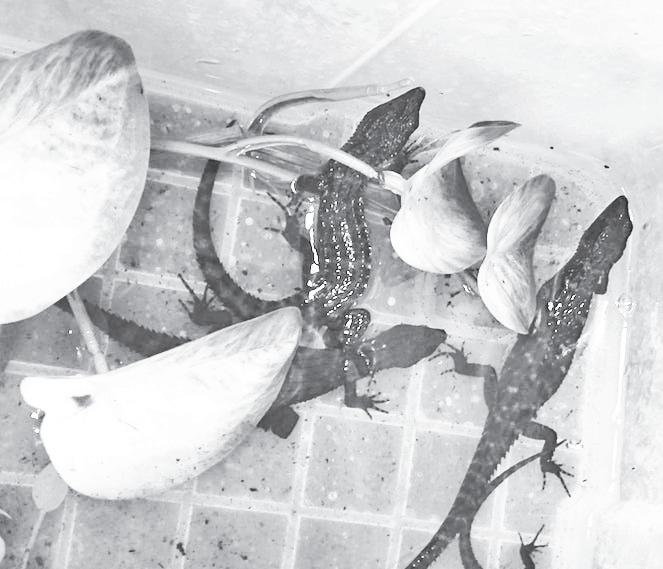
By Jonathan L. Mayuga
OPERATIVES of the Criminal Investigation and Detection Group (CIDG) of the Philippine National Police (PNP) scored a big buy-bust that led to the arrest of a prolific online wildlife trafficker in San Pablo City, Laguna, on April 4. The successful operation led to the rescue of 83 animals, including the endemic and critically-endangered Philippine forest turtle and Philippine crocodile (Crocodylus mindorensis.)
According to authorities, the suspect, which is now facing charges for violation of the Wildlife Act, has been under close watch since 2017 when his parcel containing pit viper, Philippine cobra, and sailfin lizards bound for Sweden was intercepted by airport authorities who were tipped off by Traffic, an international anti-illegal wildlife trafficking nongovernment organization. Other wildlife species confiscated from the suspect were crocodile skink, serpent Eagle, bent-toed gecko, and West Visayas water monitor.
‘Significant success’
TRAFFIC’S Emerson Sy lauded the CIDG Regional Field Unit 4A Laguna for what he calls “”significant success in the campaign against illegal wildlife trade (IWT).
“Taking down entrenched and prolific traffickers like this with access to so many endangered and endemic species throughout the country is key to making a difference in the fight against wildlife crime,” he said. “He [the suspect] is even posting his successful smuggling [activities],” Sy told the B usiness M irror via Messenger on April 10.
Getting wiser, bolder
ACCORDING to Sy, over the past few years, it appears that illegal wildlife trade has been resurrected, and illegal wildlife traders are becoming wiser and bolder.
He noted that those who sell online are hard to catch as they use different accounts and do not trust anybody to transact business with.
Sy also pointed out that illegal wildlife traders in the Philippines are not ordinary people. They are either rich or have connections, or both, as running big operations to smuggle in and out of the country those
illegally-caught or sourced wildlife requires serious money and a deep network.
While lauding authorities in its successful busting of illegal wildlife trade with the arrest of the suspects and rescue of illegally-traded wildlife, Sy said it is essential to carry out intelligence-led law enforcement actions and target key wildlife traffickers in order to combat the illegal wildlife trade.
“The recent operation by the PNP-CIDG in Laguna marks a significant achievement, as the trafficker is deeply entrenched, has access to a wide range of endemic wildlife across the country, and is a known wildlife smuggler,” he said.
Intensified operation
ENVIRONMENT Assistant Secretary Norlito Eneran, for Legal and Enforcement, said there is indeed an increasing number of IWT activities in the Philippines, which, he said, also prompted authorities to conduct intensified operation.
Citing data from the Department of Environment and Natural Resource’s (DENR’s) Biodiversity Management Bureau (BMB), Eneran said from 2020 until 2024, the number of anti-IWT operations have dramatically increased.
“In 2020, we have 19 enforcement operations. 1n 2021, 18; in 2022 76. In 2023, we have 224 recorded enforcement operations. From 2023, it again rose to 269 enforcement operations,” he said.
He added that in 2024 alone, the DENR has filed 239 cases, with 11 convictions, and three cases dismissed.
The total estimated cost of the apprehension was worth around P7,254,580.
“In terms of amount, talagang tumataas siya [it has been increasing] since 2020. What’s not recorded here was the operation in the black market, that’s why we intensified our operations,” Eneran said.
Online monitoring
ACCORDING to Eneran, because IWT has been currently operating online and through social media, the DENR-BMB is now into online monitoring potential IWT activities.
“The beauty here is, is that its not only us in the DENR that is monitoring. We have law enforcement agencies. Our CIDG, Coast Guard, Maritime Police and even the NBI
[National Bureau of Immigration] are in it now,” he said.
He said while online monitoring has intensified, the IWT happening on the ground is also being monitored. Facebook and other social media platforms, he said, are being closely watched, noting that some of the notorious IWT personalities use these platforms to buy or sell wildlife.
Proposed environment protection bureau
ENERAN said the DENR is pushing for the creation of a law enforcement bureau of its own, not only for IWT, but also for other environmental crimes like illegal logging, illegal mining, harvesting of endangered plants and targeting animals in the wild wether for food, trophy or for profit, and other so-called environment crimes.
“Currently, what we have at the DENR is an ad hoc enforcement bureau and we need our own enforcement bureau within the DENR,” he said.
Eneran said an Environmental Protection and Enforcement Bureau (EPEB)—whether a mere staff bureau or a line bureau—will boost the country’s campaign against all forms of environmental crimes.
But to have an enforcement bureau of its own, the DENR needs more funding. As a staff bureau, having the EPEB will mean an additional budget requirement of P300 to P400 million, while for a line bureau, the budgetary requirement is P2 billion to P3 billion a year.
Under a proposed measure being pushed in Congress, the EPEB shall have jurisdiction over environmental crimes and would be primarily responsible in carrying out environmental law enforcement functions throughout the country, including its air space, territorial waters, exclusive economic zones, continental shelf and other areas where the Philippines exercises sovereign rights, or jurisdiction.
The DENR’s EPEB shall coordinate with all enforcement institutions and agencies to enforce, interdict ongoing violations, arrest, investigate, and prosecute violations of environmental and natural resources law, rules an regulations, including those over which other agencies exercise jurisdiction.
It shall also be responsible in filing appropriate cases, take custody of seized and
confiscated items, implement conveyances, tools and equipment, and file appropriate cases in court together with the appropriate National Prosecution Service.
Environmental police
AN EPEB personnel, he said, shall be trained in police work, and if the situation warrants, bear arms for their safety and security.
Eneran noted that DENR personnel are facing everyday danger in the performance of their duties and responsibilities as stewards of the environment, noting that illegal wildlife traders, loggers, and even illegal miners are often heavily armed.
“Of course we really need to have our field personnel undergo police training, so that they will be qualified and compitent to bear arm,” he said partly in Filipino.
Possible budget source IN pushing for the enactment of a law that will create the EPEB, Eneran said several possible funding sources have been identified.
These area the Integrated Protected Area Fund, environmental and user fees, environment fund from the Electric Power Industry Reform Act of 2001, road users tax, and administrative fines and penalties.
The DENR may also propose additional funds through the General Appropriations Act.
According to Eneran, by having its own enforcement bureau to fight environmental crimes, the DENR will be able to take the lead, but will still work with the various law enforcement units in the PNP and Armed Forces of the Philippines, including the Philippine Coast Guard and PNP-Maritine Group, to further intensify the campaign against environmental crimes.
Eneran said as of February 2025, the Joint House Committee in Government Reorganization and Natural Resources approved the consolidated bill on EPEB. Meanwhile they are currently looking for a legislative champion in the Senate for the counterpart’s bill’s filing in the next Congress.
To ensure the bill’s passage, he said the DENR is looking at asking President Ferdinand Marcos Jr. to certify the bill as urgent, underscoring the need to intensify the fight against environmental crimes across the country.
WITH the onset of the dry season and the rising occurrence of extreme heat events due to the changing climate, the country braces for impact.
To help provide accurate and timely heat hazard information for effective execution, the Department of Science and Technology-Philippine Atmospheric, Geophysical, and Astronomical Services Administration (DOST-Pagasa) launched recently its online monitoring platform for heat index.
Called the iHeatMap, or the Interactive Heat Index Mapping and Prediction, the online platform provides nationwide access to real-time heat index (HI) data with its high-resolution, gridded heat index information for precise monitoring.
“iHeatMap empowers Filipinos with real-time, science-based heat index data—so they can make informed, timely, and potentially life-saving decisions. It is a great example of how technology and science can work together for everyday public health and safety,” said DOST-Pagasa Administrator Nathaniel T. Servando.
The heat index indicates how hot it feels by combining relative humidity with actual air temperature. It provides a more accurate representation of the “feelslike” temperature, which is crucial for health and safety.
Accessing the iHeatMap
BY visiting the platform available at the official website of DOST-Pagasa, users can check on the interactive heat index map where users can select a specific locality in the country, click the temperature button, and details such as the time and corresponding heat index will be provided for reference.
The heat index categories are also color-coded: yellow for Caution (27ºC to 32°C), yellow-orange for Extreme Caution (33ºC to 41°C), red-orange for Danger (42ºC to 51°C), and Extreme Danger (≥52°C).
The website also contains a color-coded guide on potential impacts and recommended responses.
For effect-based classification, the yellow warning from DOST-Pagasa indicates that prolonged exposure and activity may result in fatigue.
Continuing such activities could also lead to heat cramps. The yellow-orange warning signifies that heat cramps and heat exhaustion are possible, and ongoing activity could result in heat stroke.
Further, for red-orange code, heat cramps and heat exhaustion are likely, and heat stroke is probable with continued exposure, and lastly, red code warns that heat stroke is imminent.
DOST-Pagasa recommends several precautions to stay safe during hot weather. It is advisable to limit time spent outdoors, drink plenty of water, and avoid beverages such as tea, coffee, soda, and alcohol as these may cause dehydration due to frequent urination.
When outside, wearing hats, using umbrellas, and dressing in long-sleeved clothing can provide additional protection from the sun. Heavy activities should be scheduled for the cooler parts of the day, either early in the morning or late in the evening.
In case of emergencies related to heat, the weather bureau suggests moving the affected person to a shady area and having them lie down with their legs elevated.
For those who are unconscious, offer sips of cool water if they are able to swallow. Remove excess clothing, apply cool water to their skin, and ensure good ventilation. Placing ice packs on areas. such as the armpits, wrists, ankles, and groin can also help. It is crucial to call for an ambulance or transport the person to a hospital immediately if they experience severe symptoms.
The iHeatMap, available from March to May 2025, utilizes data from the European Centre for Medium-Range Weather Forecasts.
Additionally, the website provides a heat index summary, which displays the computed heat index over the past five days and the two-day forecast, organized by region and station. Rosemarie C.

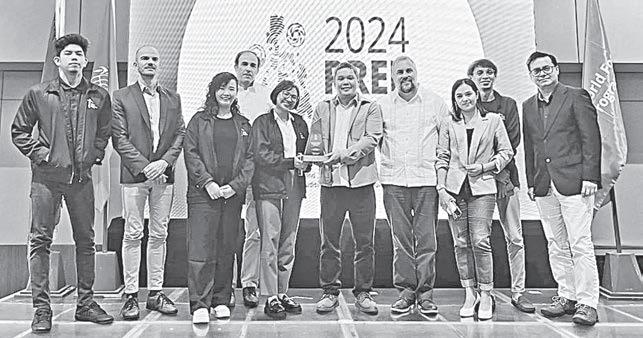
was funded by the United States Agency for International Development’s Bureau for Humanitarian Assistance (USAID-BHA).
“This system can determine whether a
neighborhood is likely to be affected by a major flood event 24 hours in advance,” Lagmay explained, noting that the system was able to forecast the flooding in Davao, Palawan, and Borongan this year.
“When accessed on the NOAH website, areas prone to flooding due to severe weather are shown in map view or tabular format, with the number of potentially affected people listed down to barangay level,” he added.
The tool can forecast flooding in specific areas based on accumulated rainfall forecasts (predicted total rainfall) and 100-year rain return flood hazard maps, which are maps showing areas prone to severe flooding based on historical data.
By adjusting global weather models to match the country’s specific geography and weather patterns, the system releases predictions that are more accurate.
The Impact-Based Flood Forecasting System was released in 2024 and has been
available for public use since then. The system empowers Filipino citizens by enabling them to validate the data it provides.
“The public can contribute information through the LyfSaver app, allowing FIlipinos to report floods in their area.” Lagmay added. Lagmay and his team also collaborated with other organizations, such as the FYT PH Media’s crowdsourcing platform, YesPinoy’s disaster response training program, and the Quezon City Disaster Risk Reduction and Management Office, as well as the Public Affairs and Information Services Department, to integrate the automated system’s features into other components of disaster risk reduction and management.
In the paper, “An Impact-Based Flood Forecasting System for Citizen Empowerment” published in the “Asian Journal of Agriculture and Development [AJAD],” the scientists acknowledged that the system has achieved some level of success, it is just the beginning of a larger process.
They emphasized that further development of the tool’s functions, collaborations among citizens and stakeholders, and good governance are essential for improving disaster risk reduction and management in the country.
“After winning the best innovation pitch among 64 entries nationwide in the Preparedness and Response Excellence in the Philippines [PREP] Innovation Challenge, we will add more hazards, such as rain-triggered landslides and possibly storm surge hazards to the forecasting system,” Lagmay shared. The PREP challenge was organized by the United Nations World Food Programme and the USAID, which seeks to identify and scale innovative and cost-effective solutions to enhance disaster preparedness and food security for vulnerable populations in the Philippines.
Citizens can donate to support this effort through the link https://resilience.up.edu.ph/ give-to-upri-and-noah-center/.
By Amanda Seitz The Associated Press
WASHINGTON—As measles outbreaks popped up across the US this winter, pediatricians waited for the nation’s public health agency to send a routine, but important, letter that outlines how they could help stop the spread of the illness.
It wasn’t until last week—after the number of cases grew to more than 700, and a second young child in Texas had died from a measles infection—that the Centers for Disease Control and Prevention finally issued its correspondence.
The delay of that letter may seem minor. But it is one in a string of missteps that more than a dozen doctors, nurses and public health officials interviewed by The Associated Press identified in the Trump administration’s response to the outbreak.
Health secretary Robert F. Kennedy Jr.’s efforts to contain an epidemic in a tight-knit, religious community in West Texas have run counter to established public health strategies deployed to end past epidemics.
“What we are lacking now is one, clear strong voice—from the federal to the state to the local— saying that the vaccine is the only thing that will prevent measles,” said Patricia Stinchfield, a nurse and infectious disease expert who helped stop a 2017 measles outbreak in Minnesota’s Somali community.
An ‘extremely unusual’ approach to the outbreak BEHIND the scenes, Kennedy has not been regularly briefed in person on the outbreak by his own infectious disease experts at the CDC at least through March 21, according to Kevin Griffis, a career staffer who worked as the agency’s communications director until he resigned that day. Even after the measles claimed its first young Texas victim in late February, Kennedy had still not been briefed by CDC staff, Griffis said. His account was confirmed by a second former federal health official, who resigned at the end of February.
A spokesperson for Kennedy did not answer specific written questions about how he had been briefed or his communications with CDC staff.
The spokesperson said the CDC activated an Atlanta-based response in early February to provide overall guidance on measles testing and vaccination strategy. An on-the-ground team was deployed to West Texas throughout most of March and withdrawn on April 1.
It was a “joint decision” between state and federal officials to send
the team home, CDC spokesman Jason McDonald said. Another team of seven was dispatched back to the region this week.
In previous administrations, health secretaries held weekly briefings with CDC staff, lasting between 25 and 30 minutes, during infectious disease outbreaks, both former HHS officials said. Kennedy, instead, received updates on paper or through email, Griffis said.
“That is extremely unusual,” said Griffis, who sat in on such briefings with the previous health secretary and said that none were held for Kennedy during his first month on the job. “I’ve never seen that before.”
In another irregularity, the American Academy of Pediatrics, the nation’s largest network of pediatricians, has not been tapped to work with the CDC on the outbreak, according to the organization’s officials. Historically, the CDC and AAP have convened for monthly or biweekly briefings during outbreaks to share updates, which include details about what doctors are seeing and questions they’re fielding from parents in exam rooms. The officials spoke on the condition of anonymity to freely discuss the health department’s response.
The only updates provided widely to pediatricians by the CDC have come from a health alert network update sent on March 7, a week after the first US measles death in a decade, and the letter sent to providers last week, which, according to the pediatric academy officials, was late in the outbreak.
Kennedy praised the CDC on Tuesday during an event in Indianapolis, saying it “had done a very good job controlling the measles outbreak.”
Kennedy endorses vaccines, but still raises safety doubts
KENNEDY’S inconsistent and

unclear message on the measles vaccines has also made the outbreaks difficult to contain, experts say.
He has occasionally endorsed the measles, mumps and rubella vaccine as “effective,” but also continues to raise safety concerns about the shots in other statements. In a CBS interview last week, he claimed the vaccines were “not safety tested.”
That approach has been the biggest flaw of the government’s response, said Dr. Carlos del Rio, the president of the Infectious Disease Society of America.
“Imagine if the captain of the Titanic had told you that you need to be careful about lifeboats and think about other opportunities,” del Rio said.
Trials were conducted on thousands of children before the vaccine was approved for use in the 1960s. The federal government has since used medical records to continue to monitor for side effects from use in millions of people since.
Health secretaries have typically delivered a clear message urging
the public to get vaccinated during outbreaks, said Dr. Anne Schuchat, a former deputy director at the CDC who retired after 33 years at the agency in 2021.
President Donald Trump and his first-term health secretary, Alex Azar, urged people to get shots during news conferences in 2019, when measles ripped through Brooklyn and infected more than 1,200 nationwide.
“You don’t necessarily need the secretary of health to attend a funeral, OK, but you don’t want to have mixed messages on vaccines,” Schuchat said. “Someone in a federal building in Washington can do a lot of harm from the way that they are messaging.”
Texas Gov. Greg Abbott also quiet on vaccines LOCAL leaders have largely been left alone to urge the public to take up vaccinations.
Texas Gov. Greg Abbott, a Republican, has not urged the public to get vaccinated, either. He has not held any news conferences about the outbreak and posted just once on social media about
measles since January. Any statements about the illnesses, which have also put 56 people in the hospital at some point, have been left to his aides.
Abbott’s office did not respond to questions about his response to the outbreak.
Governors in other states have responded more forcefully to the growing measles case count. Hawaii Gov. Josh Green, a Democrat and a doctor, made front page news last week after urging Hawaiians to take up vaccines when the state recorded its first measles case in a year.
Ahead of a busy travel week for the Easter holiday, Nebraska Gov. Jim Pillen, a Republican, unequivocally called on people to vaccinate themselves and their children. There are no known measles cases in Nebraska, but an outbreak is active in neighboring Kansas.
“If you’re not vaccinated, you’re going to get measles,” Pillen said last week.
Those types of statements are important for the public to hear leaders say from the top down, said Dr. Oxiris Barbot, who was New York City’s health commissioner during the 2019 measles outbreak. Barbot worked with local rabbis, as well as doctors and nurses in the Jewish community, to send messages that encouraged vaccine uptake. Calls from Trump and Azar, who urged the public to vaccinate, helped her make the case, too.
When national leaders distance themselves from that message, she said it “starts to erode the effectiveness of people who are trying to convey those messages at the local level.”
The Associated Press writers Paul Weber in Austin, Texas, Devi Shastri in Milwaukee and Margery Beck in Omaha contributed to this report.
By Jon Gambrell & Nasser Karimi
The Associated Press
DUBAI, United Arab Emirates — Iran ‘s president formally approved the resignation of one of his vice presidents who served as Tehran’s key negotiator in its 2015 nuclear deal with world powers, just as the head of the United Nations’ nuclear watchdog was due to arrive in the Islamic Republic on Wednesday.
President Masoud Pezeshkian’s announcement late Tuesday regarding Mohammad Javad Zarif comes as Iran prepares for a second round of negotiations with the United States over its rapidly advancing nuclear program. Meanwhile, the visit by Rafael Mariano Grossi, the head of the International Atomic Energy Agency, scheduled to start Wednesday may include negotiations over just what access his inspectors can get under
any proposed deal. The stakes of the negotiations couldn’t be higher for the two nations closing in on half a century of enmity. US President Donald Trump repeatedly has threatened to unleash airstrikes targeting Iran’s nuclear program if a deal isn’t reached. Iranian officials increasingly warn that they could pursue a nuclear weapon with their stockpile of uranium enriched to near weapons-grade levels.
Pezeshkian praises Zarif while acknowledging his resignation ZARIF served as a key supporter of Pezeshkian in his election last year but drew criticism from hardliners within Iran’s Shiite theocracy, who long have alleged Zarif gave away too much in negotiations.
In March, Zarif tendered his resignation to Pezeshkian. However, the president did not immediately respond to the letter. Zarif has used resignation announcements in the
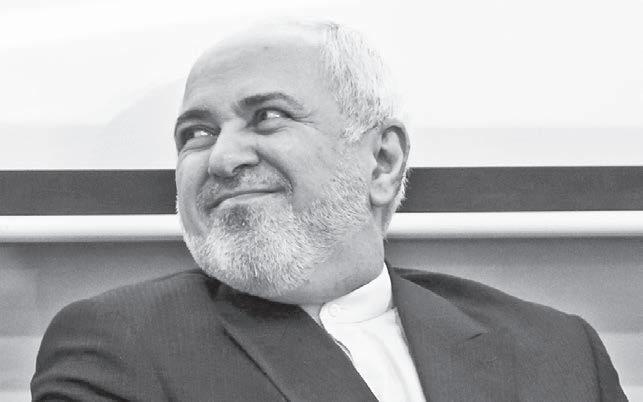
past in his political career as leverage, including in a dispute last year over the composition of Pezeshkian’s Cabinet. The president had rejected that resignation.
But on late Tuesday, a statement from the presidency said Pezeshkian wrote Zarif a letter praising him but accepting his resignation.
“Pezeshkian emphasized that due to certain issues, his administration can no longer benefit from Zarif’s valuable knowledge and expertise,” a statement from the presidency said.
The president in a decree appointed Mohsen Ismaili, 59, to be his new vice president for strategic affairs. In Iran’s political system, the president has multiple vice presidents. Ismaili is known as a political moderate and a legal expert.
Grossi visit comes as Iran has restricted IAEA access
GROSSI meanwhile was due to arrive in Tehran and have meetings with Pezeshkian and others.
Since the nuclear deal’s collapse in 2018 with Trump’s unilateral withdrawal of the US from the accord, Iran has abandoned all limits on its program, and enriches uranium to up to 60% purity — near weapons-grade levels of 90%.
Surveillance cameras installed by the IAEA have been disrupted, while Iran has barred some of the Vienna-based agency’s most experienced inspectors. Iranian officials also have increasingly threatened that they could pursue atomic weapons, something the
West and the IAEA have been worried about for years since Tehran abandoned an organized weapons program in 2003.
Any possible deal between Iran and the US likely would need to rely on the IAEA’s expertise to ensure Tehran’s compliance. And despite tensions between Iran and the agency, its access has not been entirely revoked.
Iran’s foreign minister questions contradictory responses from US envoy
IT remains unclear where the next round of talks will be held, though


they are scheduled for Saturday.
Officials initially identified Rome as hosting the negotiations, only for Iran to insist early Tuesday they would return to Oman. American officials so far haven’t said where the talks will be held, though Trump did call Oman’s Sultan Haitham bin Tariq on Tuesday while the ruler was on a trip to the Netherlands.
Meanwhile, Iran’s Foreign Minister Abbas Araghchi on Wednesday warned the US about taking contradictory stances in the talks.
That likely refers to comments from US Mideast envoy Steve Witkoff, who this week initially sug -




gested a deal could see Iran go back to 3.67% uranium enrichment — like in the 2015 deal reached by the Obama administration. Witkoff then followed up with saying “a deal with Iran will only be completed if it is a Trump deal.”
“Iran must stop and eliminate its nuclear enrichment and weaponization program,” he wrote on the social platform X. “It is imperative for the world that we create a tough, fair deal that will endure, and that is what President Trump has asked me to do.”
Karimi reported from Tehran, Iran.




By Annie Ma, Makiya Seminera & Christopher L. Keller The Associated Press
WASHINGTON—At first, the bar association for immigration attorneys began receiving inquiries from a couple students a day. These were foreigners studying in the US, and they’d discovered in early April their legal status had been terminated with little notice. To their knowledge, none of the students had committed a deportable offense.
In recent days, the calls have begun flooding in. Hundreds of students have been calling to say they have lost legal status, seeking advice on what to do next.
“We thought it was going to be something that was unusual,” said Matthew Maiona, a Bostonbased immigration attorney who is getting about six calls a day from panicked international students.
“But it seems now like it’s coming pretty fast and furious.”
The speed and scope of the federal government’s efforts to terminate the legal status of international students have stunned colleges across the country. Few corners of higher education have been untouched, as schools ranging from prestigious private universities, large public research institutions and tiny liberal arts colleges discover status terminations one after another among their students.
At least 790 students at more than 120 colleges and universities have had their visas revoked
or their legal status terminated in recent weeks, according to an Associated Press review of university statements and correspondence with school officials. Advocacy groups collecting reports from colleges say hundreds more students could be caught up in the crackdown.
Students apparently targeted over minor infractions AROUND 1.1 million international students were in the United States last year—a source of essential revenue for tuition-driven colleges. International students are not eligible for federal financial aid, and their ability to pay tuition often factors into whether they will be admitted to American schools. Often, they pay full price. Many of the students losing their legal status are from India and China, which together account for more than half the international students at American colleges. But the terminations have not been limited to those from any
one part of the world, lawyers said.
Four students from two Michigan universities are suing Trump administration officials after their F-1 student status was terminated last week. Their attorney with the American Civil Liberties Union, Ramis Wadood, said the students never received a clear reason why.
“We don’t know, and that’s the scary part,” he said.
The students were informed of the status terminations by their universities via email, which came as a shock, Wadood said. The reason given was that there was a “criminal records check and/or that their visa was revoked,” Wadood said, but none of them were charged or convicted of crimes. Some had either speeding or parking tickets, but one didn’t have any, he said. Only one of the students had known their entry visa was revoked, Wadood said.
Last month, Secretary of State Marco Rubio said the State Department was revoking visas held by visitors who were acting counter to national interests, including some who protested Israel’s war in Gaza and those who face criminal charges.
But many students say they don’t fall under those categories. Students have filed lawsuits in several states, arguing they were denied due process.
In New Hampshire, a federal judge last week granted a temporary restraining order to restore the status of a Ph.D. student at Dartmouth College, Xiaotian Liu. On Tuesday, a federal judge in Wisconsin issued a similar order, ruling the government could not take steps to detain or revoke the visa of a University of WisconsinMadison graduate student.
In a break from past, feds cancel students’ status directly AT many colleges, officials learned
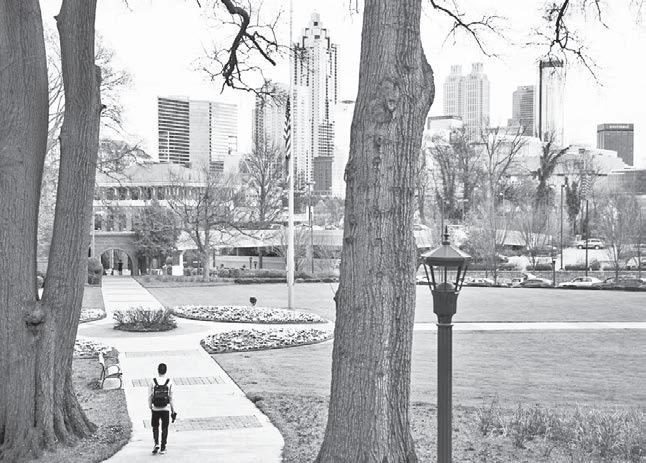
the legal immigration status of some international students had been terminated when staff checked a database managed by the Department of Homeland Security. In the past, college officials say, legal statuses typically were updated after colleges told the government the students were no longer studying at the school.
The system to track enrollment and movements of international students came under the control of Immigration and Customs Enforcement after 9/11, said Fanta Aw, CEO of NAFSA, an association of international educators. She said recent developments have left students fearful of how quickly they can be on the wrong side of enforcement.
“You don’t need more than a small number to create fear,” Aw said. “There’s no clarity of what are the reasons and how far the reach of this is.”
Her group says as many as 1,300 students have lost visas or had their status terminated, based on reports from colleges.
The Department of Homeland
Caviar has become the Costco rotisserie chicken of fine dining
TBy Madison Darbyshire
HE gleaming black-and-gold dining room at Coqodac is rowdy, and it isn’t even open for dinner yet. A table of “rappers and podcast hosts” are lingering over a late $4,000 caviar-and-champagne lunch, executive chef Seung Kyu Kim says. He doesn’t mind—he wants his Manhattan restaurant, notorious for its caviar-topped chicken nuggets ($28 per nugget), to be a place people come to celebrate.
As bird flu forces US stores to ration $10-adozen chicken eggs, salt-cured fish eggs have become inescapable at high-end restaurants. The slimy, briny spheres can now be found atop $68 sour-cream-and-onion dips in Nashville and $73 egg salads in San Francisco. But while customer perception of caviar as a luxury worth shelling out for has remained remarkably resilient for over a century, the wholesale cost of caviar—specifically, the roe from sturgeon—has dropped considerably in the past few years.
“There’s a caviar craze and each time someone asks me why, I tell them the same thing: an influx of mass-produced Chinese caviar at super low prices,” said Edward Panchernikov, director of operations at Caviar Russe, a caviar

restaurant in New York.
Wild-caught caviar is illegal under the Convention on International Trade in Endangered Species. Russian caviar, which accounts for a small percentage of the global supply, is under US sanctions. Today most caviar imported by the US is farmed in China, where low labor costs, abundant waterways and government support have helped push down prices. Accurate data is scarce—caviar makes up a small fraction of commodity imports—but the average price for a kilogram of imported caviar in the US was around $240 in 2020, down from about $440 in 2014, according to the European Market Observatory for Fisheries and Aquaculture Products. China has endured multiple food-safety scandals in recent years, as well as accusations of unfairly competing on price; importers say this has tainted public perception of its caviar industry. But the scale of Chinese aquaculture means there is enormous range in the quality of caviar it sells, even within the same sturgeon farm. The same way top vineyards can produce grapes for the most coveted wines and sell the rest for bottom-shelf grocery store bottles, the same farm can produce the finest osetra fought over by Michelin restaurants to low-grade caviar sold downmarket for cheap.


Indeed, the price of Chinese caviar can range dramatically—chefs quoted wholesale prices (including markups by importers) from $500 to $1,500 per kilogram, and retailers say it can go as low as $400. Price pressures across the market mean it can be very difficult for smaller domestic caviar farms to compete. (Marshallberg Farm, a US producer that supplies caviar to the Plaza Hotel, said its break-even cost to produce a kilogram of caviar is $1,000 to $1,200.)
Chefs note that some of the most expensive and desirable sturgeon roe in the world is coming from China.
The consistency, the flavor, and the salinity is very, very on point,” said Kim at Coqodaq. And, crucially, chefs can be more generous with their portions, creating an air of indulgence.
The Modern, a two-Michelin-star Danny Meyer restaurant in midtown Manhattan, serves a caviar hot dog on its bar menu: two cocktail wieners, each blanketed in about four grams of Chinese-farmed golden osetra caviar, on mini brioche buns for $39. Bangkok Supper Club in the West Village tops its uni and crab tartlet with the same variety, a one-bite dish for $22.
If caviar is cheaper now, why are diners still paying a premium? Part of the answer is

that customers still perceive it as a luxury, and education about varying quality has lagged the market. “Consumers aren’t thinking about it too much,” says Lianne Won, co-owner of Marshallberg Farm. “They’re thinking OK, it’s caviar. Of course it’s expensive. They’re not thinking about where it comes from.”
And despite the ascendency of Chinese caviar, when selling directly to customers, many importers still prefer not to specify country of origin. Retailer websites will claim the caviar was harvested in the immaculately clean waters of the Thousand Islands Lake, but never mention China. (China’s Qiandao Lake, which translates to “thousand islands” is where Kaluga Queen, the world’s largest supplier of caviar, is based.) “There is still some prejudice,” said Hossein Aimani, the head of Paramount Caviar, who supplies Chinese caviar to restaurants such as Le Bernardin in New York. Snobbery about provenance as a way to drive demand, and prices, is also a sacred tradition, as old as the caviar trade itself. In the 19th century, when the American sturgeon supply was abundant, the only caviar said to be worth paying top dollar for was from the Caspian Sea. American bars put domestic caviar out for free like nuts, while industrious exporters to Europe pretended their supply


Security and State Department did not respond to messages seeking comment.
Foreigners who are subject to removal proceedings are usually sent a notice to appear in immigration court on a certain date, but lawyers say affected students have not received any notices, leaving them unsure of next steps to take.
Some schools have told students to leave the country to avoid the risk of being detained or deported. But some students have appealed the terminations and stayed in the United States while those are processed.
Still others caught in legal limbo aren’t students at all. They had remained in the US post-graduation on “optional practical training,” a one-year period—or up to three for science and technology graduates—that allows employment in the US after completing an academic degree. During that time, a graduate works in their field and waits to receive their H-1B or other employment visas if they wish to keep working in the US.
Around 242,000 foreigners
was Caspian, Richard Carey wrote in his 2005 caviar history, The Philosopher Fish: Sturgeon, Caviar, and the Geography of Desire. But while caviar is having a moment, caviar in abundance, and increasingly downmarket, could threaten the industry itself. The luxurious and rare history of sturgeon roe is “under attack a bit,” said Panchernikov of Caviar Russe. “People are trying to pedestrianize it, and rid caviar of that specialness.” Menu prices stay high not just because dealers still make good margins but because—as with all things luxury — the price is the point.
“Affordable caviar is oxymoronic,” said David Stephen, an aquaculture scientist and caviar industry consultant. The roe’s true power for chefs is less about its cost than its ability to titillate. When New York’s Temple Bar started offering $20 caviar “bumps” in late 2021, they got attention “not because they were serving caviar, but because they were doing them as bumps, making fun of it,” said Rachel Harrison, a longtime hospitality industry publicist. It made customers laugh; they took pictures for social media, which brought in more customers. For $20, it felt more like ordering another drink than splashing out $200 for a caviar service.
Thomas Allan, the chef at The Modern, says the role of its caviar-topped hot dog is to capitalize on the ingredient’s ability to generate customer excitement, not margins.

in the US are employed through this “optional practical training.” About 500,000 are pursuing graduate degrees, and another 342,000 are undergraduate students.
Among the students who have filed lawsuits is a Georgia Tech
Ph.D. student who is supposed to graduate on May 5, with a job offer to join the faculty. His attorney Charles Kuck said the student was likely targeted for termination because of an unpaid traffic fine from when the student lent his car to a friend. Ultimately, the violation was dismissed.
“We have case after case after case exactly like that, where there is no underlying crime,” said Kuck, who is representing 17 students in the federal lawsuit. He said his law firm has heard from hundreds of students.
“These are kids who now, under the Trump administration, realize their position is fragile,” he said. “They’ve preyed on a very vulnerable population. These kids aren’t hiding. They’re in school.”
Some international students have been adapting their daily routines.
A Ph.D. student from China at University of North Carolina at Chapel Hill said she has begun carrying around her passport and immigration paperwork at the advice of the university’s international student office. The student, who spoke on condition of anonymity for fear of being targeted by authorities, said she has been distressed to see the terminations even for students like her without criminal records.
“That is the scariest part because you don’t know whether you’re going to be the next person,” she said.
Seminera reported from Raleigh, N.C., and Keller reported from Albuquerque, N.M.
They make the cost up elsewhere, on alcohol or dessert. “The hot dog is like a feel-good moment that makes you smile,” he said. “Chances are you’re not just going to order that, you’re going to order other things. You’re going to order some wine.” Rather than being a cash cow, “It’s more like our Costco rotisserie chicken,” Allan said, referencing the retailer’s famously inflation-proof $4.99 product. Chef Max Wittawat at Bangkok Supper Club calls the uni tartlet a “hero dish.” The restaurant isn’t making much margin on it, but it drives foot traffic, looks good on social media and—because it won’t fill you up—increases spend per customer. “China has made caviar more affordable for everyone. But at the restaurant, customers still appreciate it, they still see caviar as a luxury,” he said.
Similarly Coqodac’s chef knows people won’t order one chicken nugget and call it dinner, so he keeps the price in (relative) bounds while using fine caviar, and almost everyone wants to order one. “We’re not really making money out of this. This is just to bring excitement,” Kim said. “It’s about sustainability.” The appeal of caviar has always been that it’s a little outrageous. Like great champagne, the cost, the history and the sheer fiscal irresponsibility has always been an erotic undercurrent beneath its culinary appeal,
See “Caviar,” A15


www.businessmirror.com.ph
By Sean Murphy The Associated Press
years after a truck bomb detonated outside a federal building in America’s heartland, killing 168 people in the deadliest homegrown attack on US soil, deep scars remain.
From a mother who lost her first-born baby, a son who never got to know his father, and a young man so badly injured that he still struggles to breathe, three decades have not healed the wounds from the Oklahoma City bombing on April 19, 1995. The bombers were two former US Army buddies, Timothy McVeigh and Terry Nichols, who shared a deep-seated hatred of the federal government fueled by the bloody raid on the Branch Davidian religious sect near Waco, Texas, and a standoff in the mountains of Ruby Ridge, Idaho, that killed a 14-year-old boy, his mother and a federal agent.
And while the bombing awakened the nation to the dangers of
extremist ideologies, many who suffered directly in the attack still fear anti-government rhetoric in modern-day politics could also lead to violence.
A 30-year anniversary remembrance ceremony is scheduled for April 19 on the grounds of the Oklahoma City National Memorial Museum.
A baby killed and a mother’s anguish LITTLE Baylee Almon had just celebrated her first birthday the day before her mother, Aren Almon, dropped her off at the America’s Kids Daycare inside the Alfred P. Murrah federal building. It was the last time Aren would see her first child alive.
The next day, Aren saw a photo on the front page of the local newspaper of Baylee’s battered and lifeless body cradled in the arms of an Oklahoma City firefighter.
“I said: ‘That’s Baylee.’ I knew it was her,” Aren Almon said. She called her pediatrician, who confirmed the news.
In the hauntingly iconic image, which won the amateur photographer who took it the 1996 Pulitzer Prize for spot news photography, firefighter Chris Shields came to symbolize all the first responders who descended on the bomb site, while Baylee represented the innocent victims who were lost that day.
But for Aren, her daughter was more than a symbol.
“I get that (the photo) made its mark on the world,” Almon said. “But I also realize that Baylee was a real child. She wasn’t just a symbol, and I think that gets left out a lot.”
A firefighter thrust into the spotlight
THE Oklahoma City firefighter in the photograph was Chris Fields, who had been on the scene for about an hour when a police officer came “out of nowhere” and handed him Baylee’s lifeless body. Fields swept the infant’s airway and checked for any signs of life.
He found none.
He said the iconic photograph was snapped as he waited for a paramedic to find room for the baby in a crowded ambulance.
“I was just looking down at Baylee thinking, ‘Wow, somebody’s world is getting ready to be turned upside down today,’” Fields recalled.
While he tries to focus more on being a grandfather than politics, Fields said he has little doubt an attack motivated by radical political ideology could happen again.
“I don’t worry about it, but do I think it could happen again? Without a doubt,” he said.
A badly injured child still scarred
ONE of the youngest survivors of the bombing was PJ Allen, who was just 18 months old when his grandmother dropped him off at the second-floor daycare. He still bears the scars from his injuries.
Allen suffered second- and third-degree burns over more than half his body, a collapsed lung, smoke damage to both lungs, head trauma from falling debris and damage to his vocal cords that still affects the sound of his voice.
Now an avionics technician at Tinker Air Force Base in Oklahoma City, Allen said he had to
be homeschooled for years and couldn’t go out in the sun because of the damage to his skin.
Still, there doesn’t seem to be any self-pity when he speaks of the impact of the bombing on his life.
“Around this time of year, April, it makes me very appreciative that I wake up every day,” he said. “I know some people weren’t as fortunate.”
A son who didn’t get to know his father
AUSTIN ALLEN was 4 years old when his father, Ted L. Allen, a US Department of Housing and Urban Development employee, died in the bombing. He never truly got to know his dad.
Although he remembers snippets of riding in his dad’s truck and eating Cheerios with him in the morning, most of his memories come from friends and family.
“It’s just been little anecdotes, little things like that I’ve heard about him over the years, that have painted a bigger picture of the man he was,” Allen said.
Allen, who now has a 4-yearold of his own, acknowledges he’s troubled by the anti-government vein in modern-day politics and wonders where it could lead.
A worker’s life changed in an instant
DENNIS PURIFOY, who was an assistant manager in the Social Security office on the ground floor of the building, lost 16 co-workers in the bombing. Another 24 customers who were waiting in the lobby also perished.
Although he doesn’t remember hearing the explosion, a phenomenon he said he shares with other survivors, he remembers thinking the computer he was working on had exploded.
“That’s just one of the weird ways that I found out later our minds work in a situation like that,” he said.
Purifoy, now 73 and retired, said the bombing and McVeigh’s anti-government motives were a reality check for an innocent nation, something he said he sees in our society today.
“I still think that our country is naive, as the way I was before the bombing, naive about the numbers of people in our country who hold far right-wing views, very antigovernment views,” Purifoy said. “One thing I say to tell people is ‘conspiracy theories can kill,’ and we saw it here.”
“It’s such a similar feeling today, where you have one side versus the other,” he said. “There is a parallel to 1995 and the political unrest.”
By Brian Melley, Jill Lawless & Sylvia Hui
The Associated Press
LONDON—The Supreme Court ruled Wednesday that the UK equalities law defines a woman as someone born biologically female, rejecting the Scottish government’s argument that it includes transgender women.
Justice Patrick Hodge said five judges at the court had ruled unanimously that “the terms ‘woman’ and ‘sex’ in the Equality Act refer to a biological woman and biological sex.”
The ruling means that a transgender person with a certificate that recognizes them as female should not be considered a woman for equality purposes. But the court added that its ruling “does not remove protection from trans people,” who are “protected from discrimination on the ground of gender reassignment.”
The case stems from a 2018 law passed by the Scottish Parliament stating that there should be a 50% female representation on the boards of Scottish public bodies. Transgender women were to be included in meeting the quota.
Feminist groups that had challenged the Scottish government
Continued from A14
the reason we reach for it when the occasion feels special. But now that caviar is no longer so rare, chefs are playing with it, treating it like it’s just another ingredient, albeit one with low labor costs (they only need to open a tin). And in the case of an economic downturn, they need dishes that can draw in customers and drive spending with prices that aren’t totally out of reach. Still, the relative affordability of highquality caviar could soon change as tariffs on China hit importers, while scaled-up Chinese aquaculture threatens to push supply of midtier caviar above what the market can bear. “I hope there’s not going to be a glut, but there is a lot of caviar in the market right now,” Aimani
hailed Wednesday’s ruling as a major victory.
“The court has given us the right answer: the protected characteristic of sex—male and female—refers to reality, not to paperwork,” said Maya Forstater of the group Sex Matters.
For Women Scotland (FWS), the women’s rights group that brought the legal challenge, argued that the Scottish officials’ redefinition of woman went beyond parliament’s powers. But Scottish officials then issued new guidance stating that the definition of woman included someone with a gender recognition certificate.
FWS successfully sought to overturn that.
The group had said the outcome of the case could have consequences in Scotland, England and Wales for sex-based rights as well as single-sex facilities such as toilets, hospital wards and prisons.
“Not tying the definition of sex to its ordinary meaning means that public boards could conceivably comprise of 50% men, and 50% men with certificates, yet still lawfully meet the targets for female representation,” the group’s director Trina Budge said previously.
The challenge was rejected by a court in 2022, but the group was
said. It is likely, he said, that more restaurants will start buying up lower quality, cheaper caviar to bridge the gap. In the meantime, caviar remains ubiquitous. “Caviar has been pigeonholed by society as a luxury ingredient,” said Mike Bagale, executive chef of New York restaurant Sip & Guzzle. “I try to serve it almost at cost. I don’t want to buy into the idea of overcharging for a commodity that costs a lot, serving it in small amounts.” He serves it in a koji cool ranch “party dip” with puffed chicken skin ($125). The relative affordability of caviar today means he can be generous.
“They’re fish eggs. It doesn’t have to be super embellished or dainty or tweezered onto fish filets at a fine dining restaurant anymore,” said Bagale. He serves Greek caviar on ice cream, $70 for 10 grams. “At the end of the day, it’s salt.” Bloomberg News
granted permission last year to take its case to the Supreme Court.
Aidan O’Neill, a lawyer for FWS, told the Supreme Court judges— three men and two women—that under the Equality Act “sex” should refer to biological sex and as understood “in ordinary, everyday language.”
“Our position is your sex, whether you are a man or a woman or a girl or a boy is determined from conception in utero, even before one’s birth, by one’s body,” he said. “It is an expression of one’s bodily reality. It is an immutable biological state.”
The women’s right group counted


among its supporters author J.K. Rowling, who reportedly donated tens of thousands of pounds to back its work. The “Harry Potter” writer has been vocal in arguing that the rights for trans women should not come at the expense of those who are born biologically female.
Opponents, including Amnesty International, said excluding transgender people from sex discrimination protections conflicted with human rights laws. Amnesty submitted a brief in court saying it was concerned about the deterioration of the rights for trans people in the UK and abroad.


By Tim Reynolds The Associated Press
THEY’LL be watching in Canada, not just because of Shai Gilgeous-Alexander, though the National Basketball Association’s (NBA) scoring champion and MVP favorite who plays for Oklahoma City surely helps lure in fans who are north of the border.
T hey’ll be watching from Serbia and Greece, the homelands of Denver star Nikola Jokic and Milwaukee star Giannis Antetokounmpo. Alperen Sengun will have them watching Houston games in the middle of the night in Turkey, too. Slovenian fans will be watching Luka Doncic and the Lakers play their playoff opener at 2:30 a.m. Sunday, 5:30 p.m. Saturday in Los Angeles. Fans in Cameroon will be tuned in to see Pascal Siakam and the Indiana Pacers. Defending champion Boston features, among others, Kristaps Porzingis of Latvia and Al Horford of the Dominican Republic.
O nce again, the NBA playoffs are setting up to be a showcase for international stars.
I n a season where the five statistical champions were from five different countries, an NBA firstGilgeousAlexander is Canadian, rebounding champion Domantas Sabonis of Sacramento is from Lithuania, blocked shots champion Victor Wembanyama of San Antonio is from France, steals champion Dyson Daniels of Atlanta is from Australia, and assists champion Trae Young of the Hawks is from the US—the postseason will have plenty of international feel as well. GilgeousAlexander is in, while Sabonis and Daniels (along with Young, obviously) could join him if their teams get through the play-in tournament.
We have a tremendous number of international players in this league,” NBA Commissioner Adam Silver said earlier this season. “It’s roughly 30 percent of our players representing, at least on opening day, 43 different countries, so there’s much more of a global sense around our teams.”
B y the end of the season, it wound up being 44 different countries—at least in terms of countries where players who scored in the NBA this season were born. For the first time in NBA history, players from one country other than the US combined to score more than 15,000 points; Canadian players scored 15,588 this season, led by Gilgeous-Alexander, the first scoring champion from that country.
Gilgeous-Alexander is favored to be MVP this season. It’ll be either him or Jokic, which means it’ll be a seventh consecutive year with an international MVP for the NBA. Antetokounmpo won twice, then Jokic won three of the next four, with Cameroon-born Joel Embiid of the Philadelphia 76ers winning two seasons ago.
Shai is in the category of you do not stop him,” Toronto coach Darko Rajakovic said after a game between the Raptors and Thunder this season.
I n other words, he’s like a lot of other international guys now. Nobody truly stops Jokic, Antetokounmpo and Doncic either.
A nd this season brought another international first: Doncic finished atop the NBA’s most popular jersey list, meaning NBAStore.com sold more of his jerseys than they did anyone else’s.



Sure, that was bolstered by Doncic changing jerseys midseason when he was traded by Dallas to the Los Angeles Lakers, but it still is significant.
T he Slovenian star is the first international player to finish atop the most popular jerseys list—and the first player other than Stephen Curry or LeBron James to hold that spot in more than a decade, since soon-to-beenshrined Basketball Hall of Famer Carmelo Anthony did it when he was with New York in 2012-13. We’re so small, we have 2 million people. But really, our sport is amazing,” fellow Slovene Ajsa Sivka said when she was drafted by the WNBA’s Chicago Sky on Monday night and asked about Doncic and other top Slovenian athletes. “No matter what sport, we have at least

someone that’s great in it. I’m just really proud to be Slovenian.”
A ll this comes at a time where the NBA is more serious than perhaps ever before about growing its international footprint. Last month, FIBA—the sport’s international governing body—and the NBA announced a plan to partner on a new European basketball league that has been taking shape for many years.
The initial target calls for a 16-team league and it potentially could involve many of the biggest franchise names in Europe, such as Real Madrid, Paris Saint-Germain and Manchester City.
It was a season where four players topped 2,000 points in the NBA and three of them were international with Gilgeous-Alexander, Jokic and Antetokounmpo. Globally, time

spent watching NBA League Pass was up 6 percent over last season.
More people watched NBA games in France this season than ever before, even with Wembanyama missing the final two months. NBA-related social media views in Canada this season set records, and league metrics show more fans than ever were watching in the Asia-Pacific region—already a basketball hotbed—as well.
F IBA secretary general Andreas Zagklis said the numbers—which are clearly being fueled by the continued international growth—suggest the game is very strong right now.
“ Looking around the world, and of course here in North America,” Zagklis said, “the NBA is most popular and more commercially successful than ever.”

Foreman remembered for love of family, faith, cheeseburgers

HOUSTON—George Foreman was remembered Monday in a memorial service in his hometown of Houston for his legendary boxing career as well as for his love of God, family, horses and cheeseburgers and for his desire to help his fellow man.
He preached love all the time.
That’s what this life is all about. It’s all about love and George was pure because George lived and believed what he preached,” said James Douglas, a longtime friend and former president of Texas Southern University in Houston.
D uring a nearly one-and-a-half hour memorial service, Foreman’s family and friends recalled anecdotes about a man who was a two-time boxing heavyweight champion but who was also a pastor who delivered life affirming sermons at his church in northeast Houston and a savvy businessman best known for the George Foreman Grill.
Foreman even addressed the crowd posthumously at the Wortham Theater Center, a performing arts center that hosted the memorial, with audio messages recorded previously.
Winning and losing can never assure a lasting smile. But saying to the face you see daily, ‘I did my best,’ can,” Foreman said on the recording.
Many of the people who spoke at the memorial, including George Foreman IV, one of five sons of the boxing legend, highlighted the importance of faith in the elder Foreman’s life and how God guided his efforts to help others. ’How well do I remember how
Jesus brought me through? I prayed, I walked a night or two. I said, Lord, why don’t you take and use me? That’s all that I can do. I give my life to Jesus, what about you?’ That was a song my grandmother gave to my father. He was going through a hard time. So now I’ve given it to you,” George Foreman IV said as his four brothers stood behind him. Foreman had 12 children, including five sons who are all famously named
Edward Foreman. Rest well, dad. We will carry your
with us always,” said George
IV, who is also a pastor. F ormer boxer Michael Moorer, who Foreman defeated in 1994 to become the oldest man at age 45 to win the heavyweight championship, told the crowd that the two went from being competitors to having a relationship “built on respect for over 30 years.” George was a champion in life. His faith transformed the shy country boy from Texas to a successful businessman and a voice for the less fortunate,” Moorer said. D r. Adan Rios, a longtime friend of the boxing great, recalled how Foreman bought land to create a food bank for AIDS patients and donated $1.7 million to help treat adolescent patients with cancer.
Foreman died on March 21 at age 76. Foreman’s family has not disclosed his cause of death, only saying on social media that he “peacefully departed… surrounded by loved ones.”
Born in Marshall, Texas, Foreman was raised in Houston’s Fifth Ward, one of the city’s historically Black neighborhoods. He began his boxing career as an Olympic gold medalist in 1968, turning pro the next year. Foreman became the heavyweight champion of the world when he beat Joe Frazier in 1973. But he lost the title the following year when Muhammad Ali beat Foreman in the famous “Rumble in the Jungle” fight in Zaire. Foreman then gave up boxing and after a religious awakening, became an


The (not so ‘egg-citing’) difference between Easter egg chocolate and regular chocolate
ANYONE who has been to 19 East would agree it’s the best live music venue in the metro with its high-end sound system, great food and drinks, and friendly vibe.

Publisher :
T. Anthony C. Cabangon
Lourdes M. Fernandez
Editor-In-Chief :
Concept :
Aldwin M. Tolosa
Y2Z Editor :
SoundStrip Editor : Group Creative Director : Graphic Designers :
Jt Nisay
Edwin P. Sallan
Eduardo A. Davad
Niggel Figueroa
Anabelle O. Flores
Contributing Writers :
Tony M. Maghirang
Rick Olivares
Jill Tan Radovan
Reine Juvierre S. Alberto
John Eiron R. Francisco
Pocholo Concepcion
Francine Y. Medina
Justine Xyrah Garcia
Bea Rollo
Trixzy Leigh Bonotan
Bless Aubrey Ogerio
Photographers :
Bernard P. Testa Nonie Reyes
Y2Z & SOUNDSTRIP are published and distributed free every Sunday by the Philippine Business Daily Mirror Publishing Inc. as a project of the
The Philippine Business Mirror Publishing, Inc., with offices on the 3rd Floor of Dominga Building III 2113 Chino Roces Avenue corner
Dela Rosa Street, Makati City, Philippines. Tel. Nos. (Editorial) 817-9467; 813-0725.
Fax line: 813-7025
Advertising Sales: 893-2019; 817-1351,817-2807. Circulation: 893-1662; 814-0134 to 36. www.businessmirror.com.ph
That’s why every band worth its salt wants to play there.
Only problem is, time flies with all that fun and, before you know it, it’s way past bedtime and you’re so woozy to go home.
It has happened to me many times, especially when 19 East owner and Black Cows band leader Wowee Posadas joins the table.
On several occasions, I’ve found myself catching the sunrise.
The good news is, 19 East now has its own boutique hotel for those too tired to head home after watching a great gig, as well as travelers with an early flight to catch at Naia.
Soundstrip engaged Posadas in an online chat about 19 Inn.
What’s the idea behind 19 Inn?
PEOPLE go to 19 East for excellent dining and watching top-notch shows. Now it’s branching out into the hospitality industry with a boutique hotel aptly called 19 Inn. The goal is to make the lodging experience special and memorable and make guests come back for another visit.

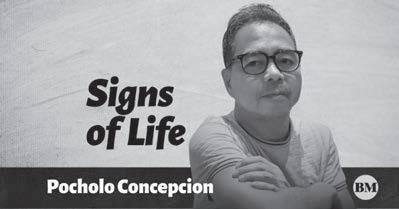

What are the factors you considered in building it?
REGULAR customers of 19 East consist not only of folks from the southern part of Metro Manila, but also those coming from distant areas like Quezon City and Marikina, to name a few. Others come from the provinces and also abroad. Inevitably, there has been a consistent demand for lodging places nearby.
So, 19 Inn was constructed a few meters from 19 East to afford guests the convenience of accessibility to the music venue. Considering the proximity of the place to a major highway (the South Luzon Expressway), to public transportation and to the airport, the location is ideal for transients, business travelers and tourists as well.


Tell us more about it — how many rooms, how big are these, the amenities, etc.
19 Inn offers personalized service and a stylish aesthetic aimed at providing a comfortable stay. The three-story hotel has 10 rooms. Each room has an area of 15 square meters, and is well appointed with an ensuite bathroom, a window-type aircon, a dining table, and a flat-screen TV.
Amenities include toiletries and personal care items, towels, free drinking water, free WiFi, and free parking. Just like the interior design of 19 East’s music hall, eye-catching artworks were installed along the corridors and other public spaces.
The individualized decor gives the getaway a warm and welcoming atmosphere that will appeal to art-loving guests.
Great news is, the introductory, budget-friendly rate per day is P1,500 only.
Any difficulties or challenges you encountered during its construction?
THE lodge was completed in early 2020, but the launch was impeded by the onset of the pandemic. Consequently, the structure was left unattended for about two years. When the country finally opened up after Covid, we discovered the building had been ransacked by intruders.
Walls and ceilings were broken. Aircons, as well as electrical equipment, were stolen. But major repairs and renovation have been carried out and everything’s fine now.
What do you think is 19 Inn’s main appeal to its guests?
19 Inn will make it possible for customers of 19 East to treat themselves to a staycation and enjoy the ease of walking to the music hall to attend events without having to rush. 19 Inn would also be a great option for those who are planning a night out, but want to avoid the danger of driving home intoxicated.
Thai Jazz
talks about a dreamy kind of jazz for a new generation
By Ica Hontiveros-Cheng
DRESSED in a white polo shirt with her brown hair in soft curls up to her shoulders- a classic look for a classic ‘gal. Thai jazz singer VARITDA comes up on screen. She is all smiles and is soft-spoken, as she answers the questions I prepared and we talk over zoom.
Her new single ‘twenty-first’ which I listened to on repeat before our interview celebrates simple love, the music video highlights love in the mundane ways, and I think that that’s just beautiful.
We talked about how Jazz and dream pop were becoming more popular recently, with singers like Laufey who are bringing pop-jazz into the mainstream. Laufey had a concert in Manila recently, and the audience were largely made up of young girls, with the genre now attracting a younger generation of fans. I asked Varitda why she thinks that’s the case.
“There’s something special about jazz music” she muses. “It’s timeless and very emotional and when its blended with a dreamy and modern production,like what Laufey does, it becomes relatable to younger audiences, it’s easy to listen to, its soothing, with a touch of it being nostalgic and romantic but in a way that it still feels fresh. I think that’s the point. And I think that people now are craving authenticity and Laufey was able to do that (be authentic). I think that Jazz and dream pop is something that will be growing more and more.”
I asked Varitda how she was inspired by Jazz. How did she discover it? And if it was something that she listened to growing up? Maybe it was something that she picked up from her parents?
Varitda confirmed that: “Yes, definitely, I grew up with music from
Nat King Cole, Frank Sinatra, Ella Fitzgerald, and from recent ones such as Norah Jones, even Laufey!”

WE then talked about her song writing process. I asked Varitda: “You work with a number of collaborators like: Jamie Song, PYC, and NACHE CHAN. What is it like working with a team and are you open to working with other artists from outside of your team?”
“Of course, I like working with a team. It has been such a beautiful experience for me. Each person brings something unique to the table, to the song, they bring their own style, their sound, their energy, we blend everything and that’s the collaboration which brings the music to a whole new level. I got very lucky that I found each of them like Jamie, PYC and Nache. They really understand my vision. And yes, I’m actually open to working with other artists outside my label. I think music would be more interesting when more worlds collide, when more genres blend together as well,” she answered.
Of course I had to ask- “Do you have any artists in mind that you would like to work with?”
“I have many actually but if I can dream maybe Bruno Major or Laufey?” She says laughing.
We then turned into the specifics of her song writing, I asked her: “Can you

share with us how you write your songs? How do you work with a team? What is your creative process like?”
“For this song (twenty-first) I cowrote the melodies with Jamie from Korea, and PYC wrote the lyrics for me. For the melody I think we did a really great job and it turned out beautifully. For PYC, he is a really good friend of mine. And for personal songs like this one, I prefer someone who is really close to me and knows me really well to write the song. I gave a lot of input into the writing of the song and it turned out like me. I actually am kind of an introvert, so the lyrics of the song turned out to be really subtle. I’m not good at expressing myself and so I’m glad that the song turned out beautifully.” Varitda said.
We then focused on her latest single ‘twenty-first’. “About ‘twenty-first’ it’s very special to you, it’s personal, since it’s a tribute to your own wedding anniversary. When you write a song, do you usually take from your own experiences or do you take from what you see in films, or from people around you?” I asked.
Varitda answered: “It can be both, but mostly I think it’s from myself, something that I really know and I can portray it easier. I think I can also
pick up things from movies and other stuff, like combining life experiences to become my song, yeah that can work too.”
Curious about how she would want to celebrate her own anniversary I asked. “Given the chance, if you had the time and budget, how would you like to celebrate your wedding anniversary?”
Varitda thought for a while before answering: “Well, I am someone who always appreciates the quiet meaningful moments in my life, I want something that is intimate, like a concert under the stars with close friends and family. Maybe Laufey can be the artist? She asked, laughing. “Good music, moonlight and good food, that’s the kind of celebration that feels truly special to me.”
Before wrapping up our chat I asked her if we will be seeing her in the Philippines anytime soon.
Varitda lights up at this. “I hope so! I really hope so. I’ve heard so many amazing things about the Philippines, the music scene there, and how passionate the fans are there. If the opportunity comes up, I will definitely be there in a blink.” she said smiling.
I assured Varitda that we are a very romantic people, and that her songs will definitely be a good fit here.
“It would be an honor to be there to share my music with you guys.” Varitda said.
By Margaret Murray of Swinburne University of Technology & Andrew Costanzo of Deakin University
EASTER is here. By now, you surely have seen chocolate Easter eggs on supermarket shelves, or have bought some already.
The million-dollar question is this: Is there a difference between Easter chocolate and the everyday kind? Does Easter chocolate really taste better, as some people say? As we’ll see, any difference is less about the ingredients and more about how we experience the chocolate when we eat it.
Tale of the tape
WHEN we compared the ingredients and nutrients of Easter egg chocolate and regular chocolate from the same company, we found no major differences.
Cadbury Dairy Milk hollow Easter egg and Cadbury Dairy Milk chocolate block both contain (per 100 gram) the following: about 2,200 kilojoules of energy
7g protein
31g fat
55g sugar
Both products have a minimum 24 percent milk solids. The egg has a marginally higher percentage of cocoa solids (28 percent) than the block (27 percent). If they contain pretty much the same ingredients, what else is going on?
It’s more about the taste, texture and smell
THE difference between Easter chocolate and regular chocolate is more about how we experience the flavor of chocolate–via taste, texture and smell.
Taste is the recognition of simple ingredients dissolving in saliva and entering the taste pores on our tongue. In the case of chocolate, we perceive the taste as sweet (sugar), fatty (cocoa butter) and potentially bitter (caffeine and other cocoa-based compounds).
However, texture and smell make us most likely to tell the difference between Easter and regular chocolate.
The mouth is incredibly sensitive to the texture of foods. We perceive multiple physical qualities of a food, which we call “mouthfeel.” Smoothness, creaminess and
is made and stored also impacts its texture. Sometimes, chocolate gets a whitish haze on its surface called chocolate bloom. This is when the fat and sugar separate from each other, forming fat or sugar crystals.
It is safe to eat chocolate with bloom, but it may taste less creamy or grittier than chocolate without bloom.
Because the demand is so high during Easter, chocolate manufacturers sometimes use rapid-cooling techniques to produce hollow Easter eggs at a faster rate. This may make them more susceptible to chocolate bloom. Cheaper Easter chocolates using these rapid procedures may have a different texture than chocolate made the traditional way.
Finally, smell contributes the most to
‘How someone eats chocolate can also change its flavor. One study categorized people who ate chocolate as ‘suckers’ or ‘chewers.’’
mouthcoating (for example, an oily feeling) are important components of chocolate’s mouthfeel.
Consumers also expect round-shaped chocolate to be creamier than angularshape chocolate. So even before we’ve taken a bite, we perceive a chocolate egg will be creamier than a block. These expectations can shape how we experience the flavor of chocolate.
However, if the chocolate egg is not as creamy as expected, this can be disappointing.
The temperature at which chocolate
how we perceive flavor in foods. When chocolate starts to melt in our mouth, aromas are released. These aromas make their way through the back of the nose where we smell the complex scents and notes of chocolate. Depending on the chocolate, this could include fruity, earthy, buttery or floral aromas.
The shape of chocolate
WE’VE already heard the shape of chocolate influences how creamy we think it is. But the shape of chocolate also influences other aspects of our eating experience.
Easter chocolate in the shape of an egg or an animal provides a large contact area inside the mouth meaning it will melt faster than a block. This impacts how quickly aroma compounds are released from the chocolate.
Biting into hollow chocolate, such as eggs and animals, may also require more time to chew and swallow. This results in Easter chocolate spending longer in our mouths with a greater release of aromas. This means we perceive a greater intensity or diversity of flavors compared to eating small squares.
Are you a sucker or a chewer?
HOW someone eats chocolate can also change its flavor. One study categorized people who ate chocolate as “suckers” or “chewers.”
Chewers tend to swallow chocolate more quickly and may perceive it to have a weaker flavor because of the shorter time for aromas to be released. That’s the reason why the manner a person eats Easter chocolate may also impact whether they prefer it over regular chocolate.
Easter is only once a year LAST of all, eating Easter eggs (and hunting for them) are often part of a shared family ritual. This can make Easter chocolate seem special. No wonder we enjoy the whole Easter egg experience.
So, whether you are a sucker or a chewer, Easter is a great time to slow down and celebrate with loved ones. Enjoy and savor your Easter chocolate in moderation, eggshaped or otherwise. The Conversation
n Cover photo by alleksana on Pexels.com
These Easter eggs have been decorated by the Sorbian community for thousands of years
SCHLEIFE, Germany—Anke Hanusch dips her tool into dark blue wax and dots it precisely on a yellow-dyed Easter egg in her hand. Back and forth, wax to egg, egg to wax, as the honeycomb pattern grows.
The intricate motif means the egg will ultimately be a gift from a godparent to their godchild, to bestow diligence and a good work ethic upon the youngster.
The tradition of decorating Easter eggs is part of the culture of the Slavic-speaking Sorbian ethnic minority in Germany. Modern-day Sorbs are descended from Slavic tribes in Central and Eastern Europe who settled in Germany some 1,500 years ago.
About 60,000 Sorbs currently live in Germany, split between the federal states of Saxony and Brandenburg.
Easter is the biggest holiday of the year
STEPHANIE BIERHOLDT, an employee at the Sorbian Cultural Center in Schleife, a town just 16 kilometers from the Polish border, said Easter is the biggest holiday of

the year for Sorbs and people travel home to celebrate with their loved ones.
“The best thing is that this tradition is still alive in families,” she said.
Bierholdt, Hanusch and other members of Schleife’s Sorbian community gathered at the cultural center on April 6, two weeks ahead of the holiday, to celebrate their heritage through Easter eggs and traditional folk costumes, songs and dances. Sorbian egg decorating dates back to the Middle Ages.
From chicken eggs to emu eggs HANUSCH wore the red folk costume

and bonnet of an unmarried woman; married women wore green. She was among more than 30 artisans selling their Easter eggs at the cultural center. Her prices ranged from the cheapest decorated chicken egg for 7 euros ($7.72) up to 90 euros ($99.28) for a painted emu egg.
The decorating can take between 90 minutes and six hours, depending on the techniques used, the motif and size of the egg. The artisans use a needle or the tip of a goose feather quill, cut in different ways, to draw the designs.
The egg artisans said the worldwide bird flu outbreak, and subsequent egg shortage


and price hikes, have not yet affected their craft—though they added that it’s always best to get eggs directly from a farmer rather than a supermarket.
Hanusch, who is Sorbian on her father’s side, is learning to speak the Slavic language. She said she and other Sorbian children start decorating Easter eggs as young as two, from when they can first hold a pencil. Many only do it during the Easter season throughout childhood, but Hanusch continued with the skill and became a teacher to others, including her niece.
“I think it’s a valuable cultural asset that needs to be preserved,” she said. “It would be a shame if it were to become extinct.”